Finishing Up!
This last week flew by! We were sad to see the end of the season, but are happy that it has been such a good and productive few months with a great group of hardworking people. We got things done even though it was the last week, spending the beginning of the week working on making more brush mats and installing more fish cover logs. We put a few more in each of the watersheds and felt very accomplished for doing better than some of the season work goals we had set.
We also spent Thursday going around to our parks one last time to tidy them up for the fall. We hope you get out to enjoy our hard work! We mowed and whippersnipped each location and weeded the pollinator gardens to ensure that the pollinator-friendly plants were not getting choked out by weeds that are less favourable. We have had these gardens for four or five years now and are happy to see so many of the plants taking off and doing really well, as well as observing pollinators throughout the season taking refuge in these gardens.
On the last day we cleaned up one of the beaches in our jurisdiction and then paddled down the Westmoreland Estuary to check on things and celebrate the end of the summer. Thanks for sticking along with us, and we hope to see you with our 2026 Season Blog next summer!
Love, SSWA
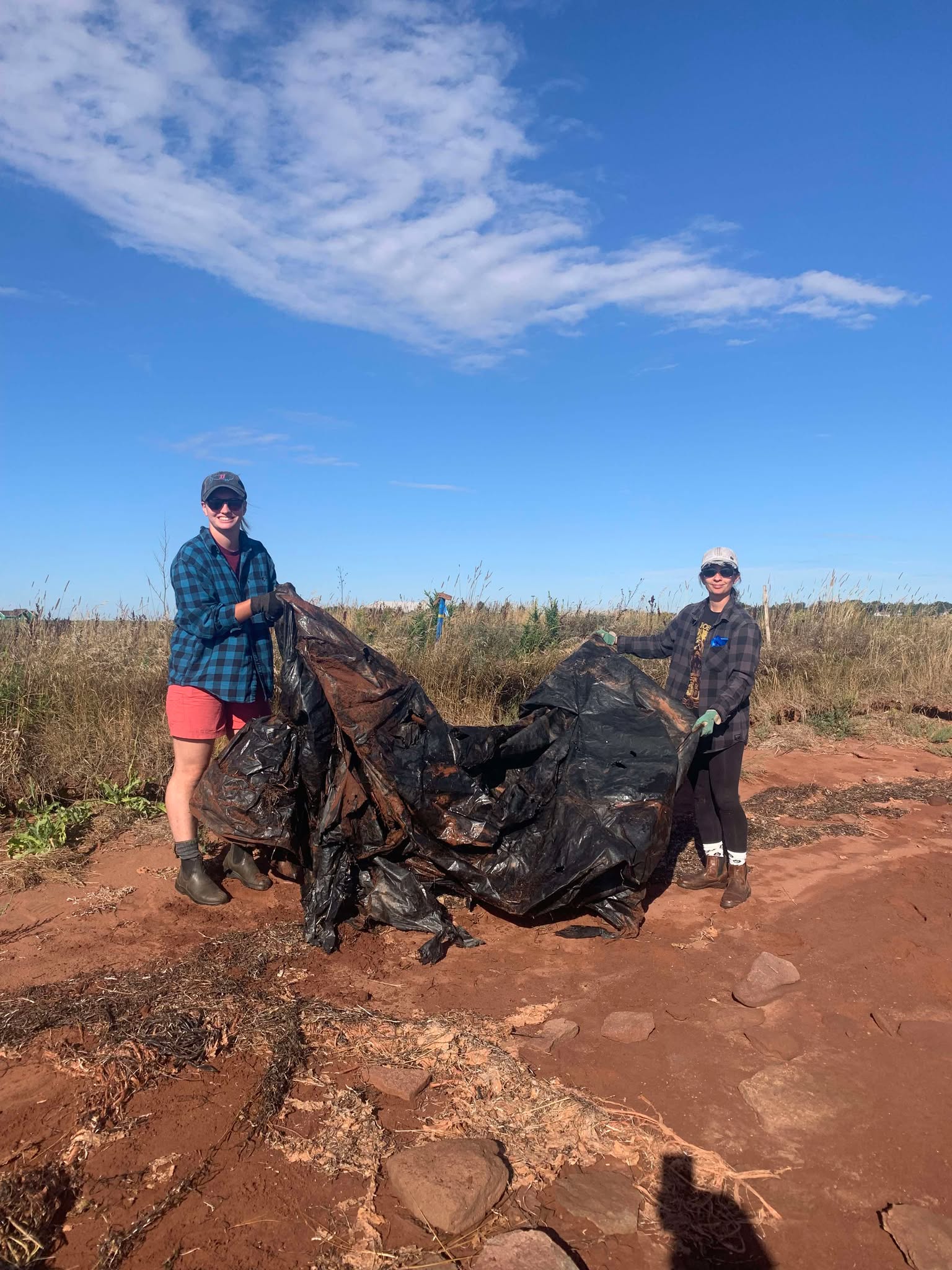
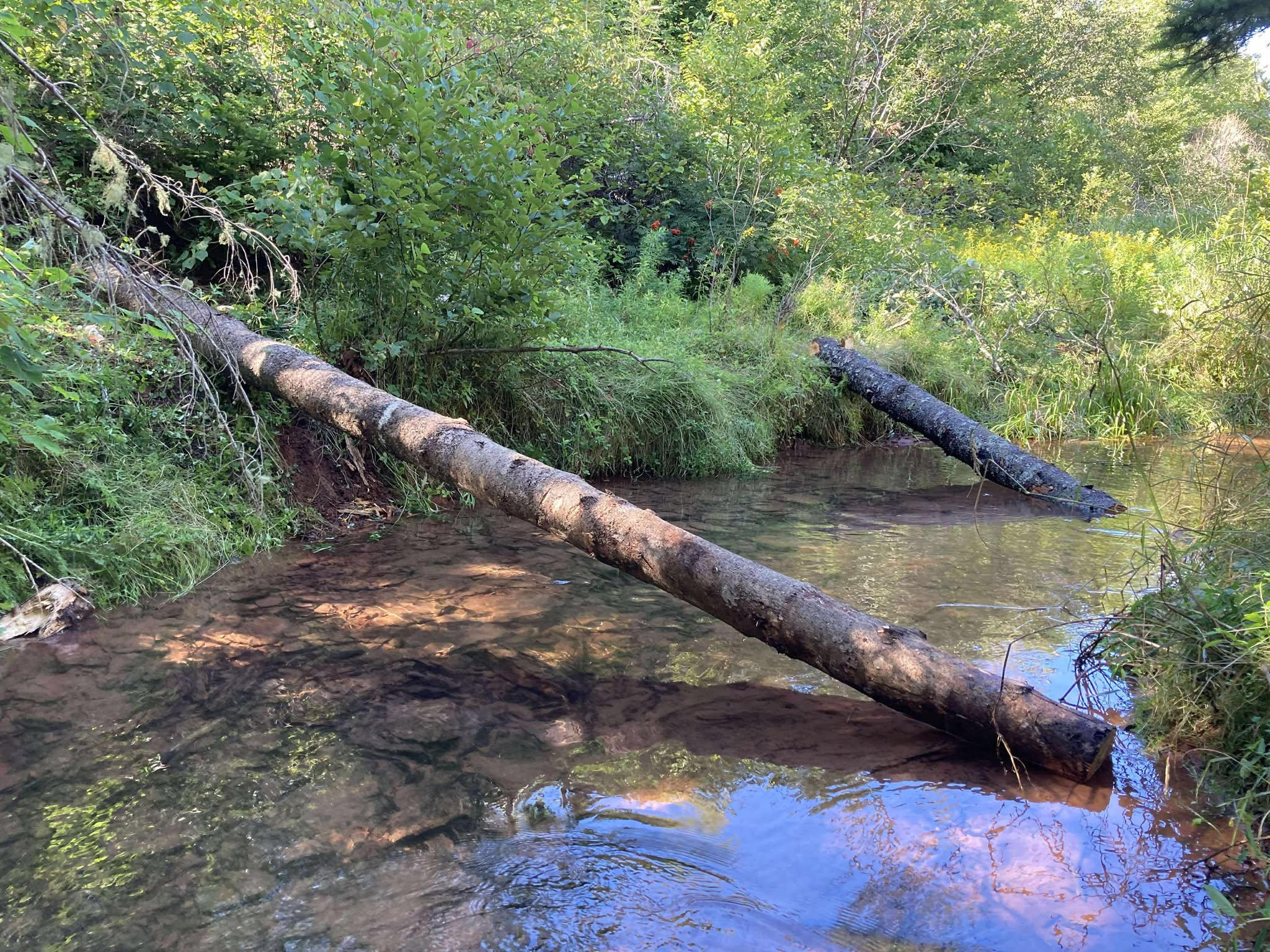
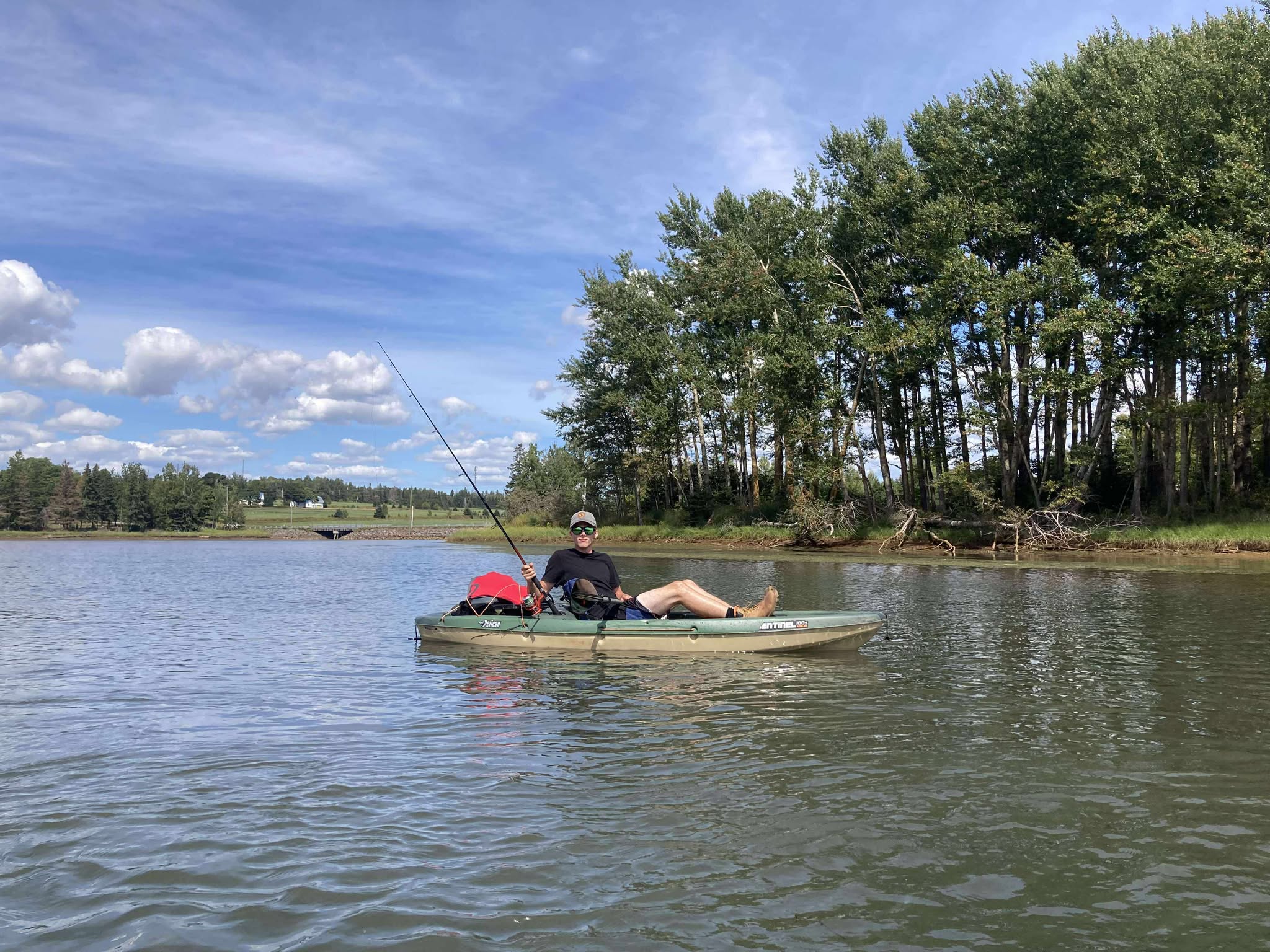




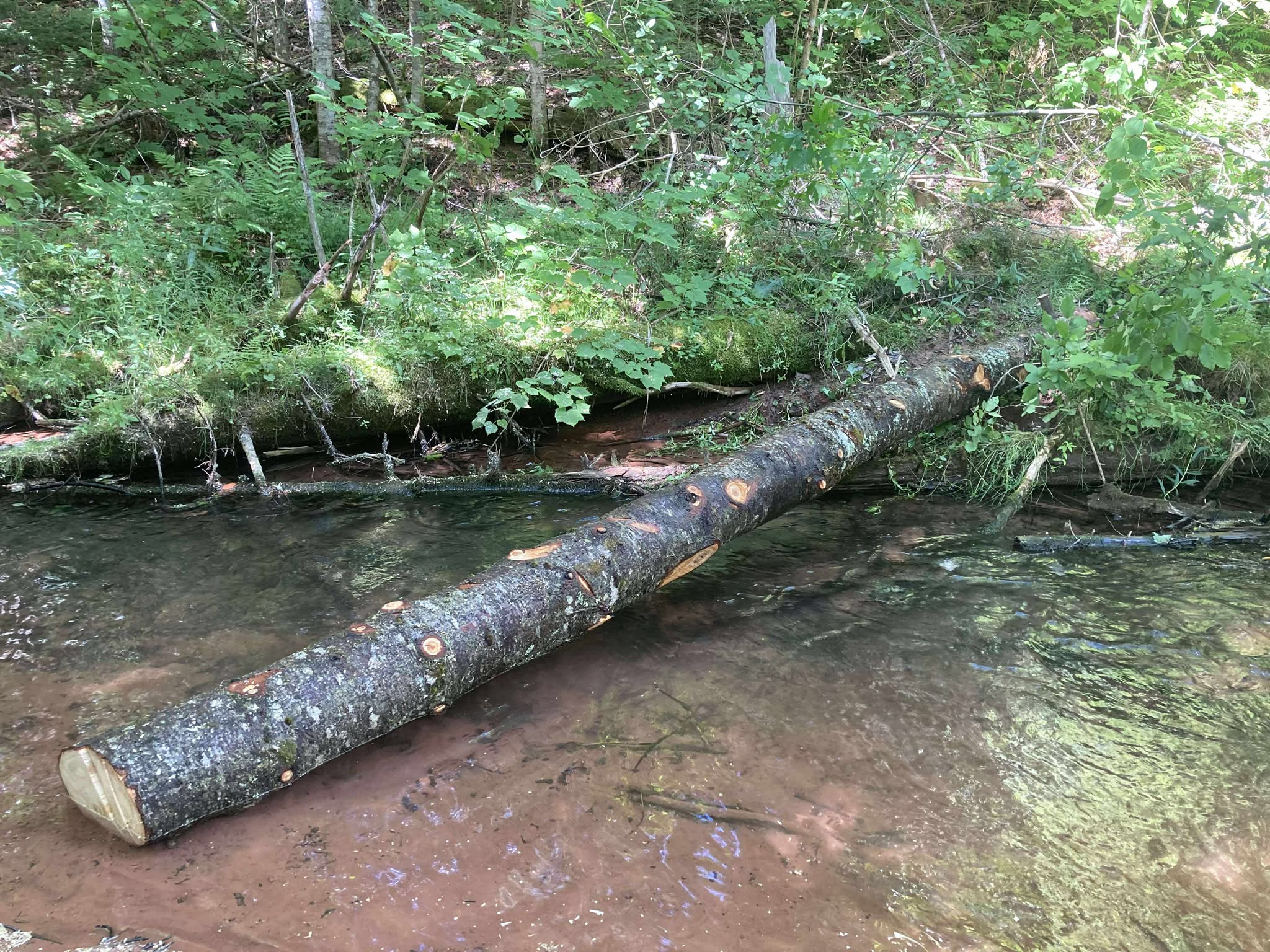

Covering Ground
Hey everyone, hope you enjoyed the beautiful weather this week! We sure did, and especially on Saturday with our Swim for the South Shore. A huge thanks goes out to everyone who showed up and supported us. It was a great turnout and an exciting day was had by all. If you didn’t manage to make it, we hope to see you next August!
The rest of the week was spent working on tasks to finish up the field season. This coming week is our last with the field crew (they will be missed!) and we want to make sure that we have all of our in-stream restoration work done by then. This meant more brush mats made in each of our three main watersheds–DeSable, Westmoreland, and Tryon–and also a new focus on fish cover logs. This is something that is newer to the current crew and they tackled it with vigor. These logs are cut from dead trees and are positioned at an angle over pools in the stream. They help provide shade for the fish and help keep the water temperature down, but most importantly they provide cover from airborne predators to the fish. This provided many opportunities for teamwork and hard thinking as we needed to move the logs around and make sure we were cutting them safely.
Thursday saw us conducting the penultimate water quality check for the season. Things are looking good, even with that very hot week in there, and we are pleased with the water conditions despite the low levels of pretty much all of our watersheds. It’s always interesting to compare the results with previous years and see where there might be differences and similarities.
Friday we started building some birdhouses to expand our swallow monitoring program. These boxes are specifically designed to help with bird banding and have a hinged lid. They are extremely useful, but also more complicated than the normal bird boxes we make, but we were up for the challenge. It was a good way to switch up what we were working on and get started on preparation for next season at the same time. We are looking forward to installing the boxes and hopefully finding birds in them next spring!
We hope you all are doing well as the summer winds down and are looking forward to fall. Wishing a few more good beach days to everyone on the island!
Love,
SSWA
Dang We’re E-fish-ent!
The week began with the crew being refreshed on the procedure for electrofishing. Equipment was calibrated and tested, making sure everything was ready for the upcoming fieldwork. Once everything was set up we headed off to do our first stream with the help of Rebecca from the PEI Watershed Alliance. Got lots of fish and set the bar for the rest of the week.
The next day electrofishing began early to beat the scorching heat. We got two spots done for the day before the heat started overwhelming us. We were finding that there was a mix of brook and rainbow trout in our streams but higher up on the systems there were less rainbow trout or sometimes none. We were happy to see this as the rainbow trout is an invasive fish species which often outcompetes native brook trout and salmon.
The third day was like the day before trying to beat the heat and get two sites in the day to meet our goal. This time we didn’t have as much rainbow in the streams which is a good sign for our brook trout. This day though we were hoping for a big brook trout as of last year we got our biggest one, sadly there were no big ones but was still a successful day.
Thursday went straight into electrofishing. It was a smooth day as at this point everyone in our crew had a good handle on all the jobs we did. We made sure everyone got around to each job either: netting, bucketing, measurement, or water quality.
The final day came and finished up our final two sites. These streams didn’t have as much action as the past electrofishing days but was still a good working day. A good sign to end the electrofishing week was all the brook trout that we were finding.
It was a well productive week pushing through the heat was the hardest part but in the end we met our requirements with hard work but also fun memories.
Quick reminder that our Swim for the South Shore is this weekend and there is still time to register!!! We’d love to see you there.
Love, SSWA
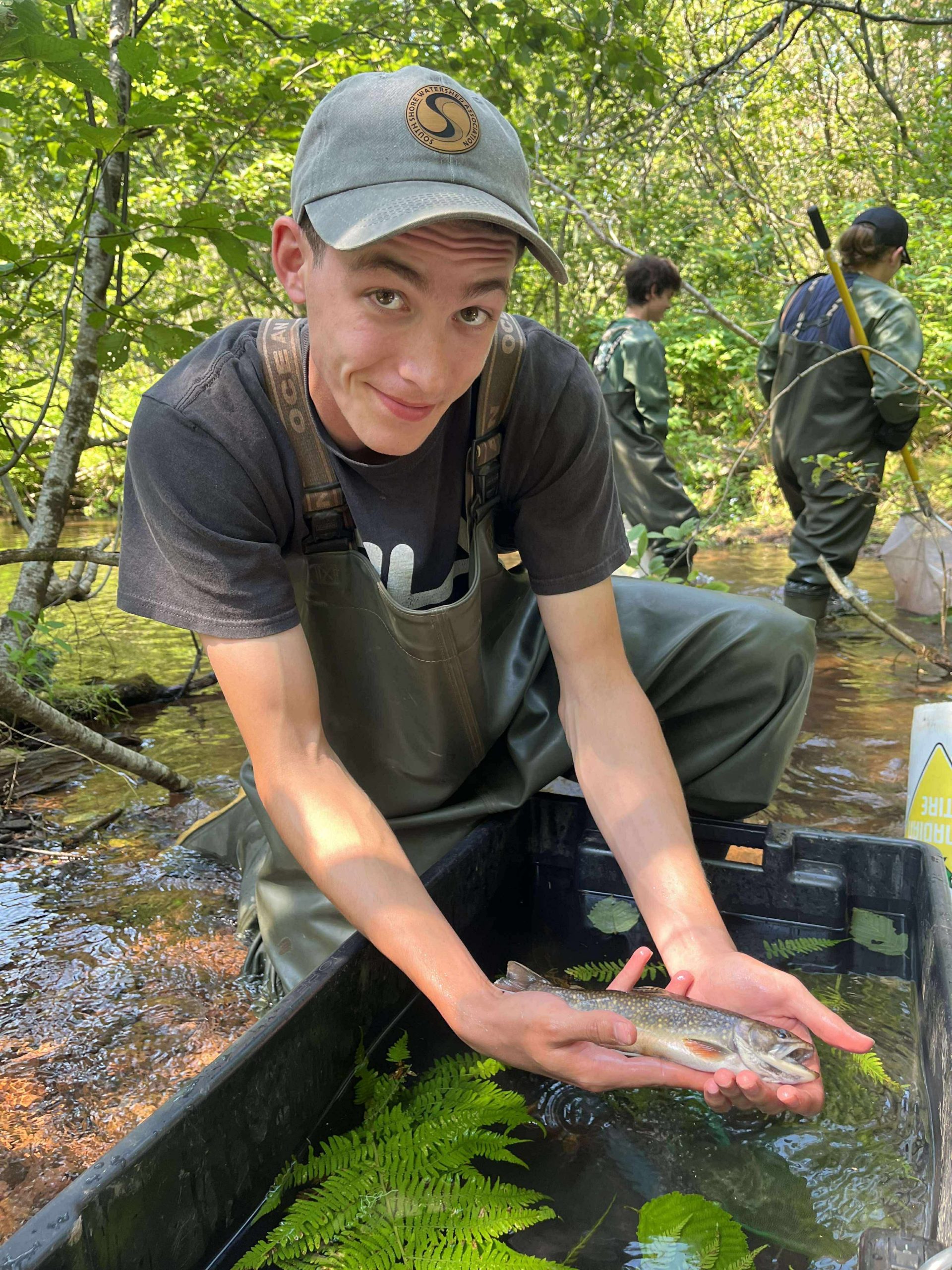
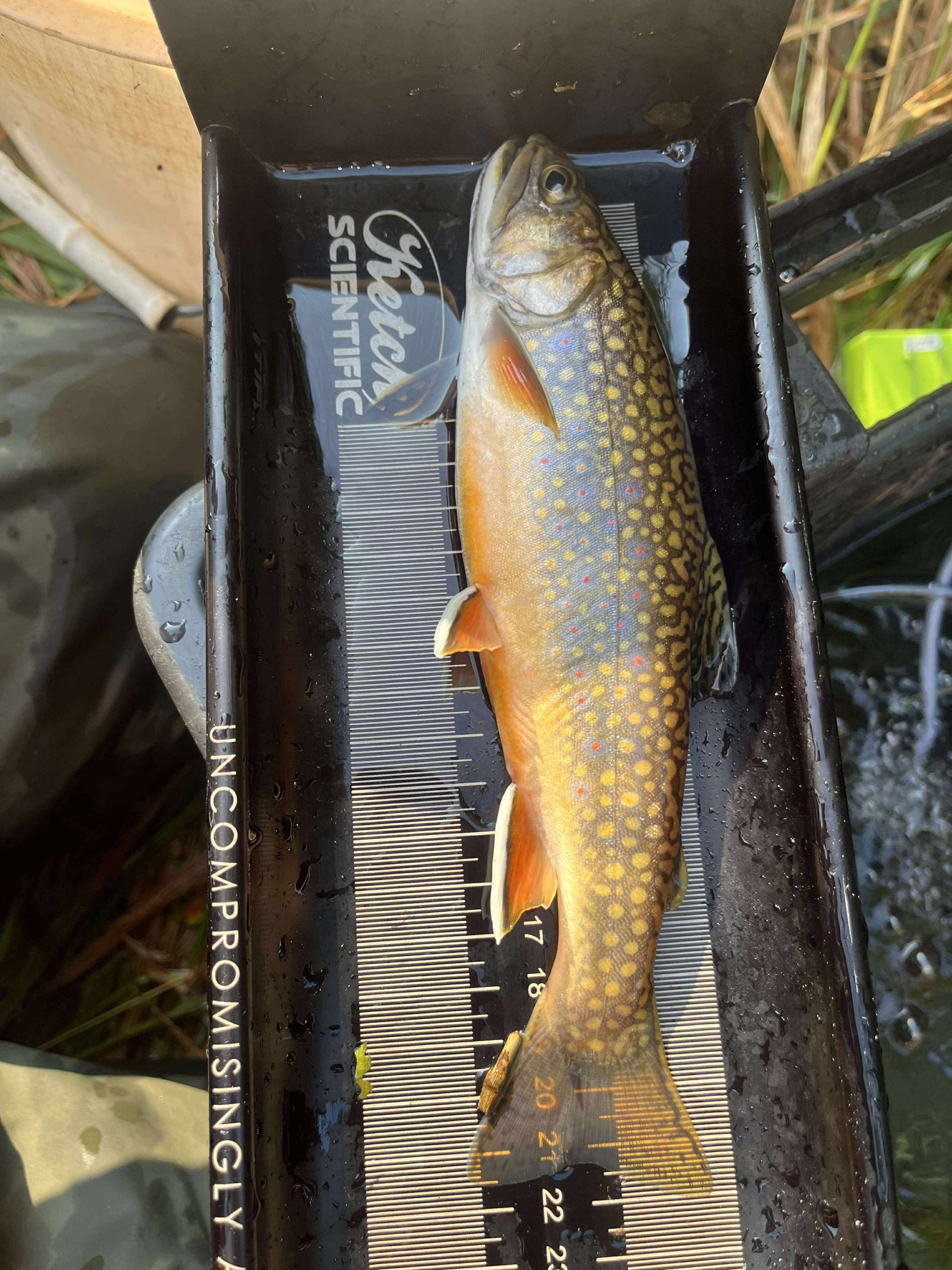
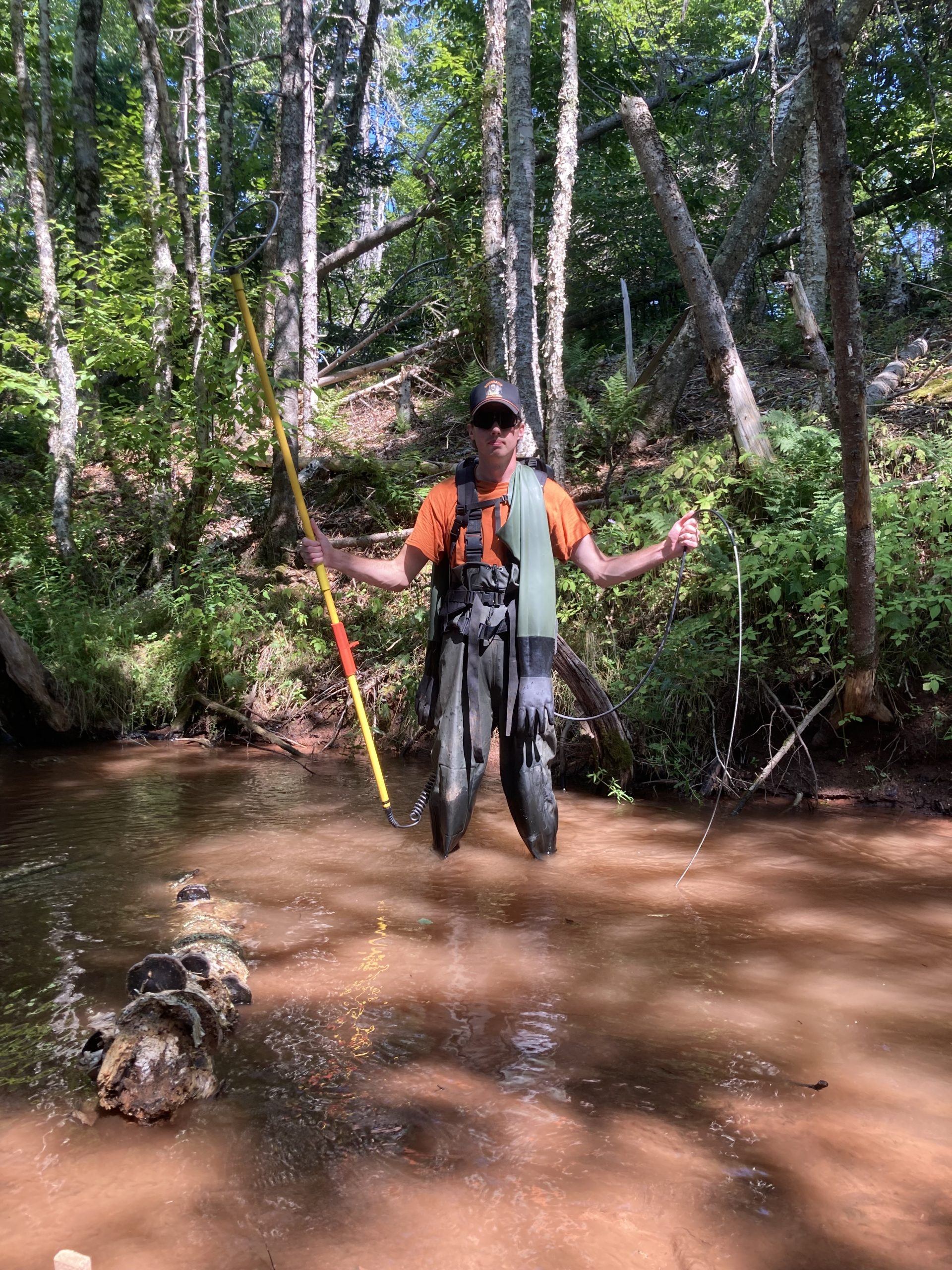
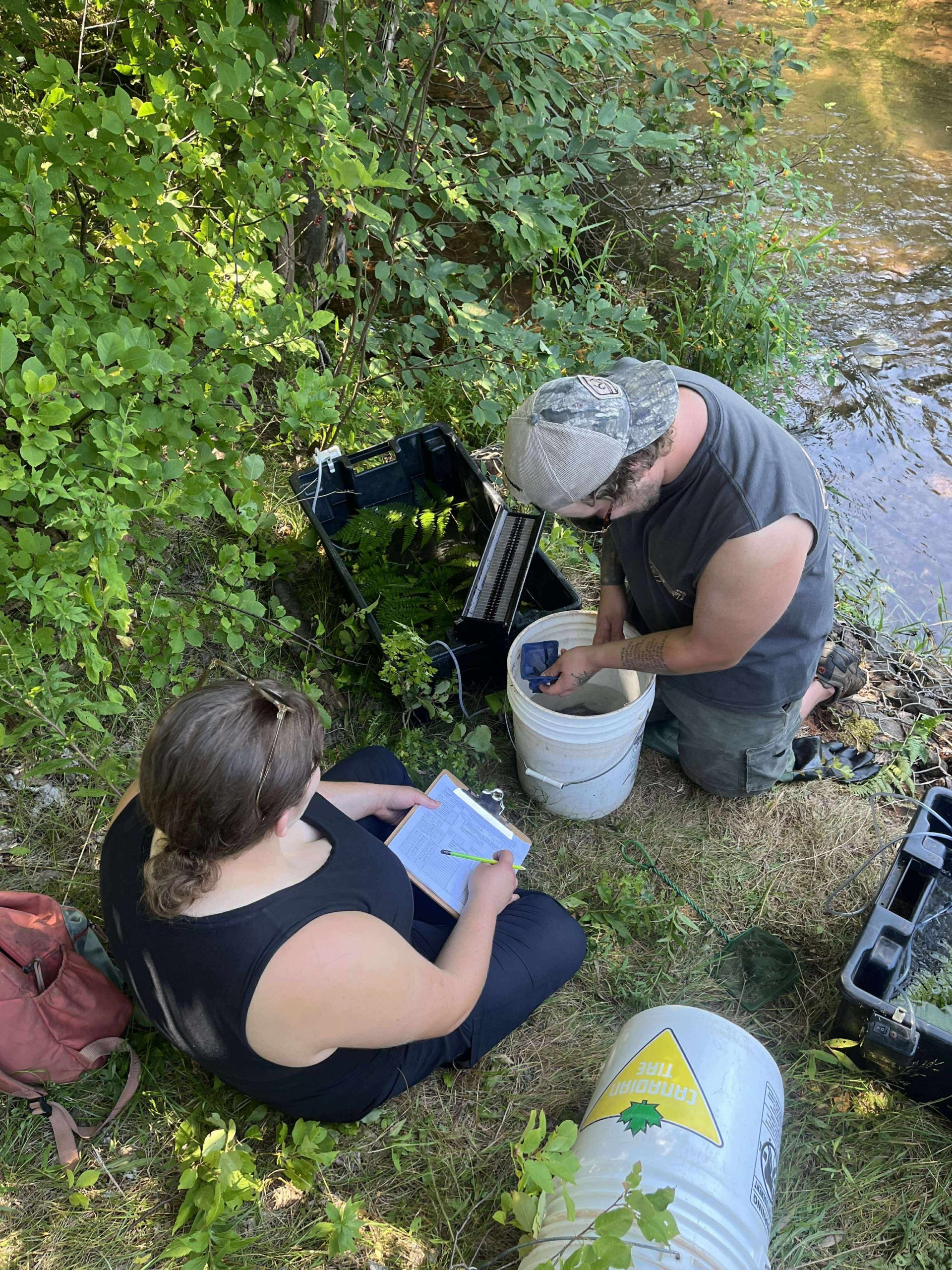
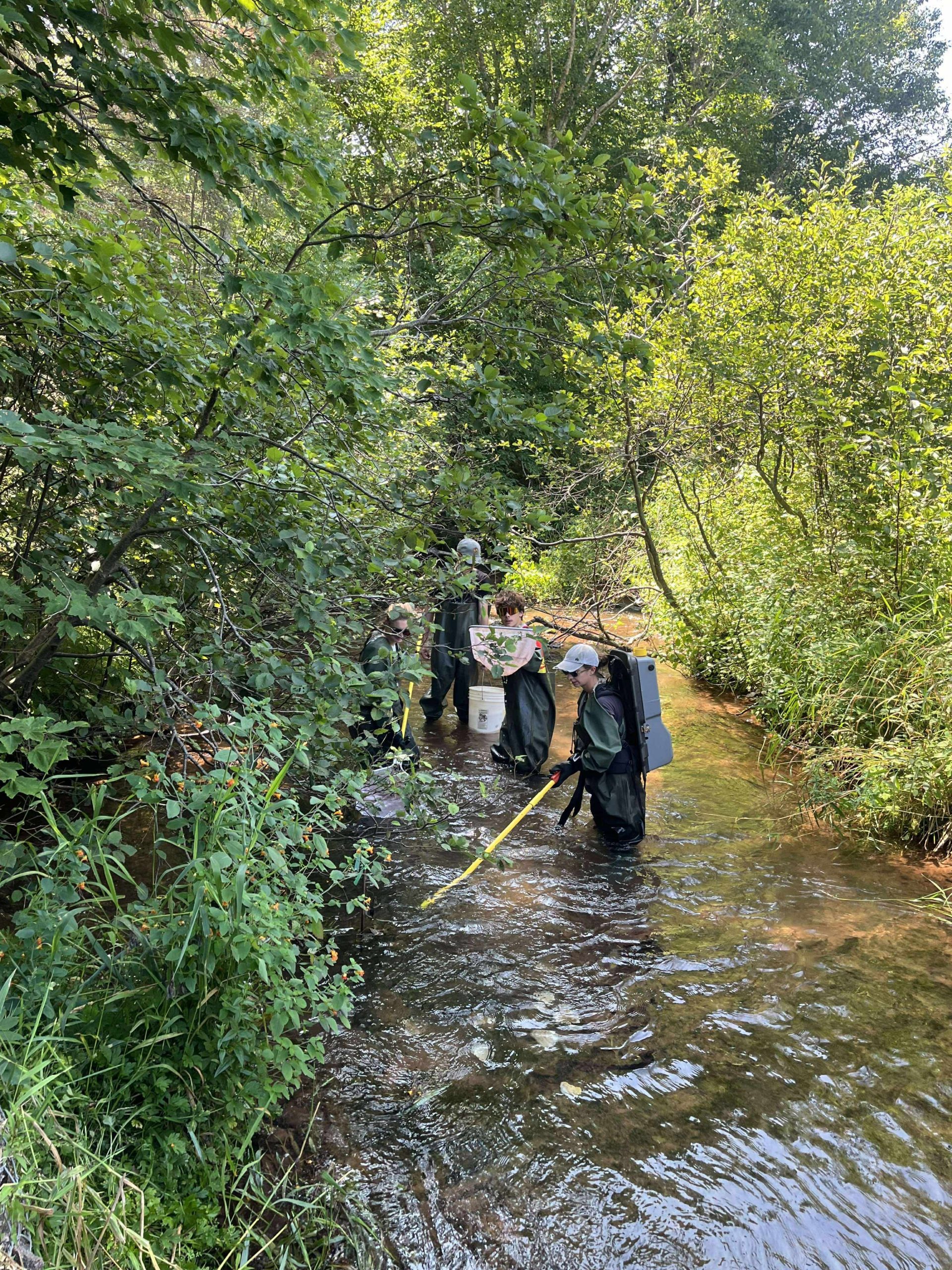

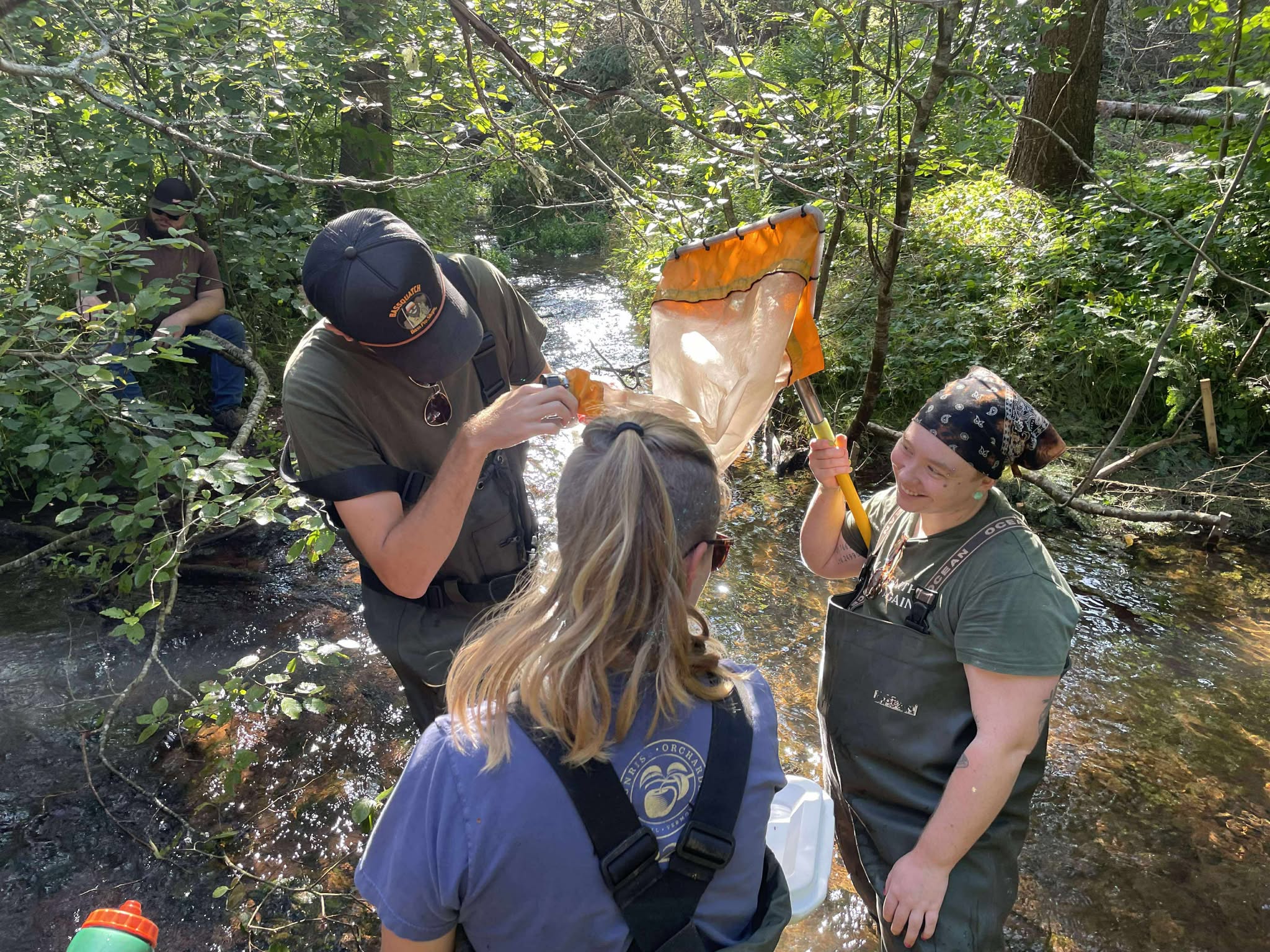
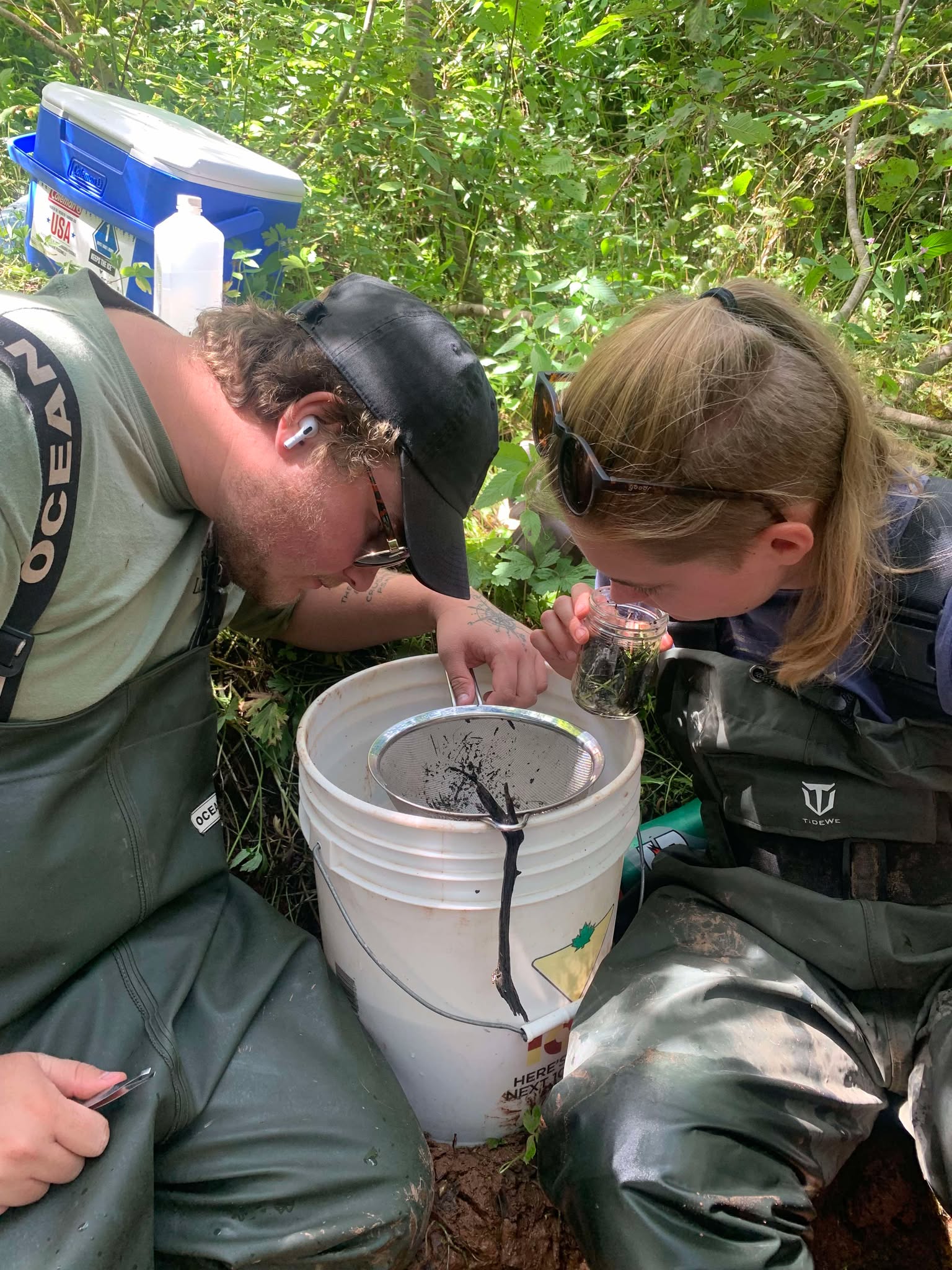
Rockin’ It
This week’s main focus has been the assessment of macroinvertebrates in various streams throughout the watershed.
On Tuesday the whole crew set out together to collect macroinvertebrate samples from the stream below Linden Hill Pond. Senior staff guided newer staff in utilizing the CABIN protocol. By using a kicknet, macroinvertebrates are collected, then sorted into specimen jars for later analysis and identification. The sample area was measured, and sediment size recorded by measuring 100 pebbles to give a mean value. The embeddedness of the pebbles was also assessed.
In the afternoon, two teams were created, one to work on brushmats, and the other to assess the stream on Balaklava W.
Wednesday looked quite similar, with the team doing macroinvertebrate sampling along Balaklava E. , Old Town Road, and Route 13.
Thursday morning started off with macroinvertebrate sampling once again, first at Branch Rd., then at Maple plains. The team was quite excited to come across a bald eagle nest during sampling. Much like macroinvertebrates, bald eagles can also serve as bioindicators. Their presence not only suggests there is healthy forest habitat available, but also indicates that their ecosystem is relatively low in contaminants.
In the afternoon, two teams were formed. One team continued with macroinvertebrate sampling at Mill Rd., while the other worked on surveying bank swallows in Victoria and Cumberland Cove. Estuary surveys were also completed at a few select spots.
Friday, two teams were created. Team one surveyed macroinvertebrates, while team two tackled park maintenance. After lunch, various end of the week tasks were completed, including tidying the office and equipment, watering trees, and doing some trail maintenance at Tryon River Trail.
Love, SSWA
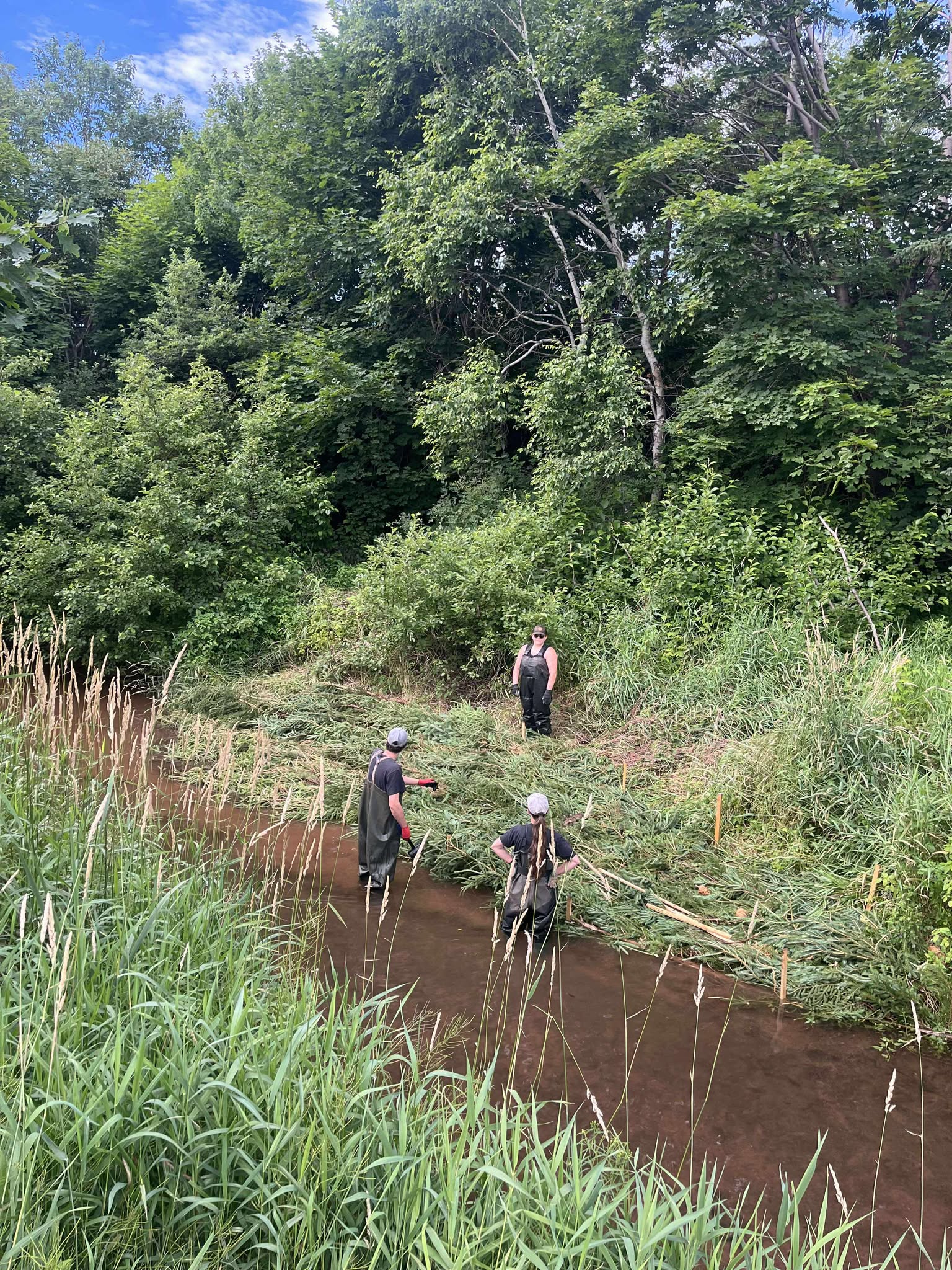

Restoring our High Spirits
This week we lost Nout for the summer (due to his pursuit of academia) and Romy took off for a week camping trip in Quebec, so the crew was whittled down for the week ahead. Monday the crew had a rocky start, losing Cameron and Rohan due to sickness for the day. That being said, the remaining crew, being adaptive as ever, still managed to prevail despite their circumstances by successfully completing a good portion of stream restoration in Tryon. This took most of the morning and pushed deep into the afternoon. To finish off the day, after some late lunch, the squad cleaned the living heck out of the equipment shed and sharpened those chainsaws as though there were no tomorrow. Shout out to Ian for that.
Tuesday we saw the return of Cameron and Rohan; a great start to the day. When we decided we would be going back to Tryon to restore another large portion of the stream. After that Ian and Matt did some chainsaw maintenance and drew up some bird box blueprints. The rest of the team decided to finish off the day with some brush harvesting from a kind landowner on South Melville who gave us access to land with many spruce trees. We loaded up the trailer with the high quality brush we harvested and dropped her all off behind the Crapaud Hall for tomorrow’s activities.
Wednesday we started the day off with yet again the whole darn team! The squadron decided to head back yet once again to Tryon to finish up the final stretch of stream. At around noon, the gang decided to wrap things up and head back to the office. Our troubles of crew illness and ailments weren’t yet over with, so both Cameron and Rohan decided to head home for the day. Now with a crew of only four, Matt and Theo went to the electrofishing refresher course while Ian and Raelyn reviewed trail camera photos.
Thursday plans went awry, as our two master chainsaws were both barred from clearing to keep themselves (and others) safe in light of their ongoing injuries. The rest of the team constructed some brushmats in Crapaud using the brush from the previous day. In the afternoon the crew went to the Amar property to check if the trees we previously planted needed watering (they didn’t) and then went around to the parks to get a status update on what kind of maintenance was needed for Friday (a good amount). To finish off the day, with the help of a really kind coastal property landowner in Hampton, the crew planted marram grass on the shore next to an eroding cliff. Hopefully these efforts will preserve the cliffs for many years to come. Only time will tell.
Friday. No Raelyn or Rohan. The crew, being thin once again, split up into teams. Teo and Ian started the morning off by doing some much needed park maintenance at our local parks. Cameron, still hurting, stayed at the office and wrote the blog. Fletcher was hard at work getting the poster for this weekend’s Pride Parade completed so they could walk with our beloved board member, Daphne. Cameron and Matt then went around the area and passed out posters for the SSWA Swim. Upon Matt’s return he showed us the taxidermy he acquired from Forest, Fish and Wildlife for the Crapaud Exhibition. We finished off the day by cleaning up the office, setting up our stand at this weekend’s Crapaud exhibition. Although it was a bit of a rough week, SSWA pulled it off (as if there was any doubt!)
We hope to see you this weekend at the exhibition, or out in Charlottetown at the Pride Parade. If you see our SSWA sign pass, give us a wave!
Love, SSWA
Brush Mats Everywhere!
This week we continued with more of the same and a fun new project!
On Monday we did some restoration work on the DeSable river, managing woody material and putting in brush mats. This has been what we have been doing for the past few weeks, and we are switching it up by working in different locations. It feels good to be connecting fish passage between areas we had been working on previously, and we are happy to report that we have put in more brush mats than ever before.
Tuesday marked more brush mats, but in a very special location. As a continuation of the estuary restoration project we were working hard on last year, we are experimenting with brush mats in the estuary to hold sediment. When we experimented with salt marsh grass growth in different materials, they did well enough in the brush mat material that we thought we should test it in the environment and not just the lab. We are excited to see what happens and glad to be doing science!
Wednesday we were back in the stream doing more of the same, and removing invasive species that inhibit native species and block stream flow. In the heat, we also removed some invasive species at one of our park locations, continuing the battle against invasive species colonizing these areas. We got a lot done even though everyone was moving slower than usual. Hope you all were staying cool as well!
Thursday, we put in a few more brush mats on the DeSable river to help manage sediment and protect the banks of the river. We also measured water quality across all five watersheds. These 17 locations are measured using different parameters once a month throughout the summer season as a way to keep track of the state of the streams, even those we are not in all of the time.
Friday was a big day since it was Nout’s last day working for SSWA. At the end of the month he is heading off to pursue a degree in the Netherlands and we are very excited to see what he learns, although he will be missed on the crew with his hard work and sense of humor. We continued to work on the part of the Westmoreland River we have spent the past couple of weeks working in, and finally connected up to the section we had restored last year. Exciting stuff!
We hope you are thinking ahead to the end of August and the Swim for the South Shore! You can find out more information and register at this link, and check out our social media for some FAQs! It should be a great time with live music and prizes! Come on out and support the work that we do to keep the streams happy and healthy.
Be there or be square!
Love, SSWA
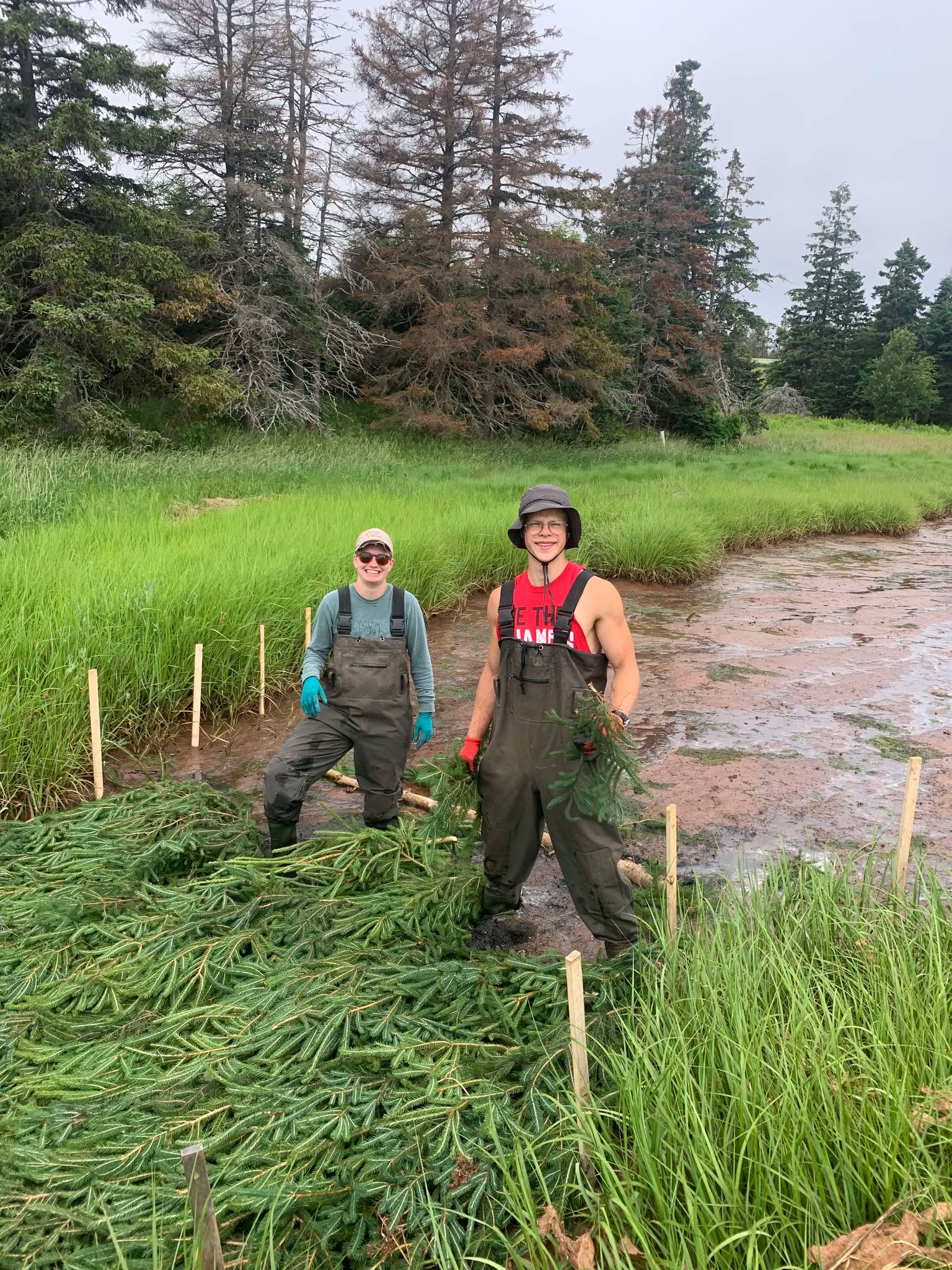
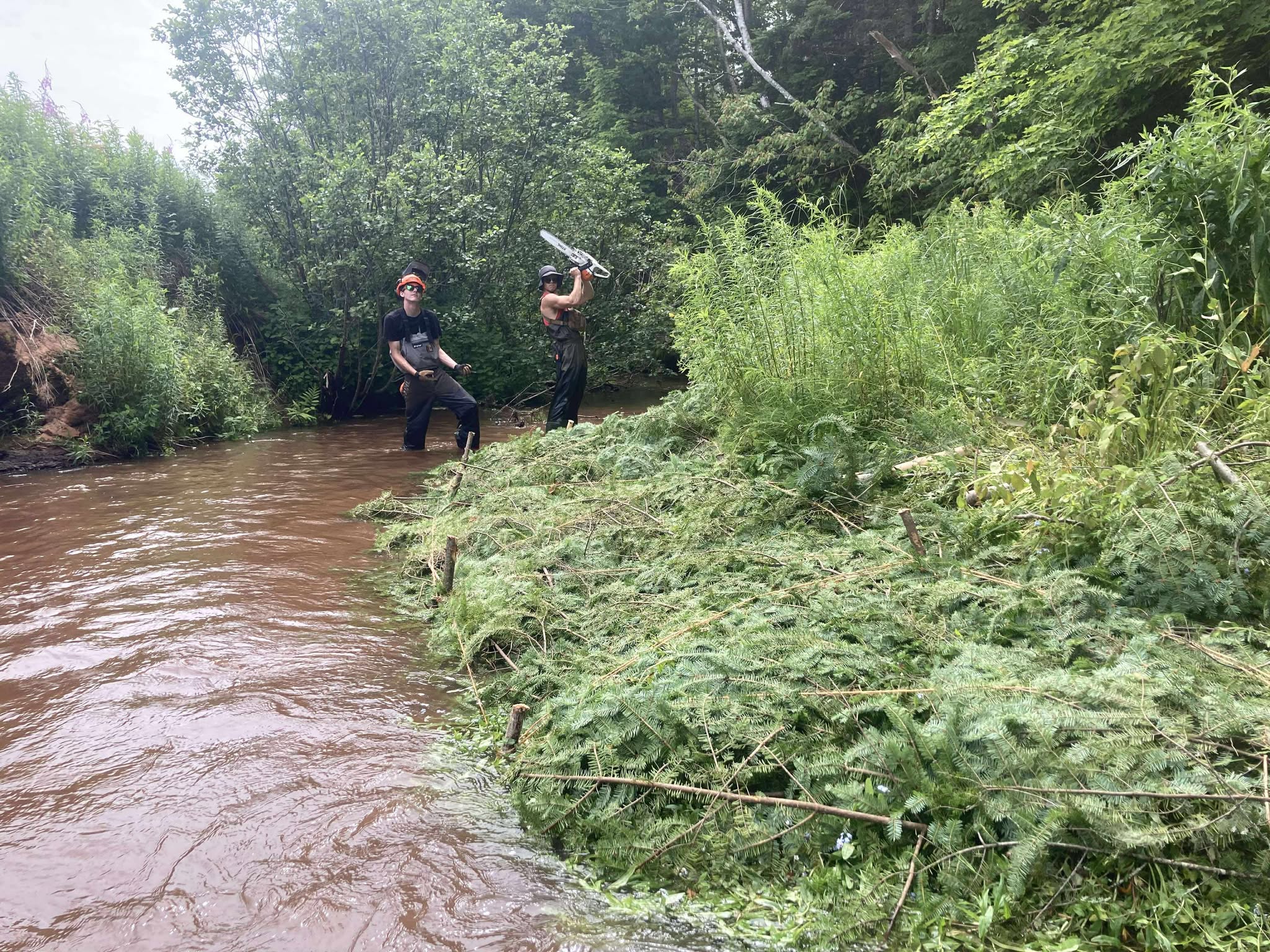




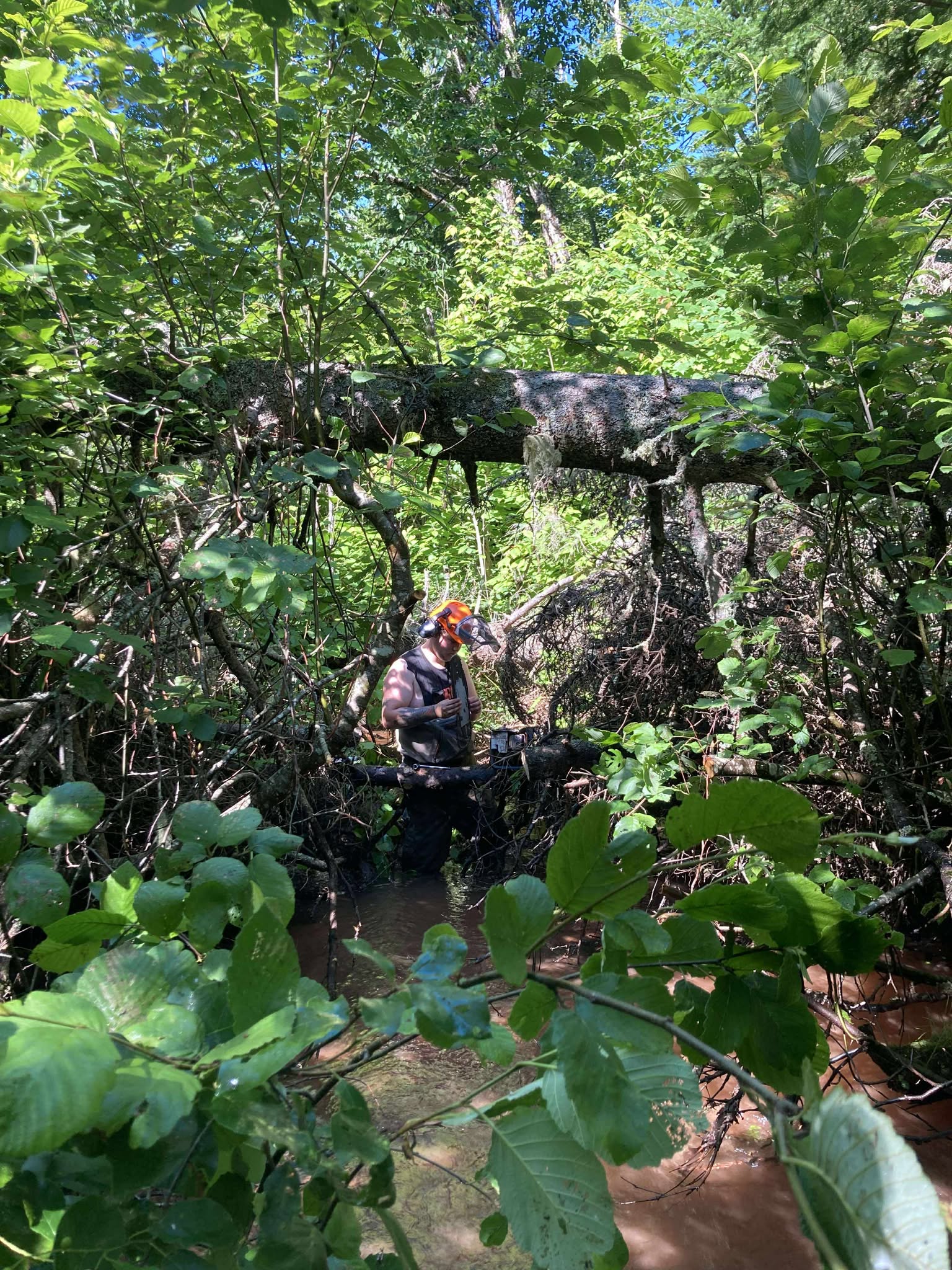
Restoring our High Spirits
Hey everyone! We are back with another riveting blog update for you on the goings on from this week.
Monday, the crew started off with stream restoration on the eastern side of Westmoreland river. The team also worked on invasive species removal above Ives Pond in Tryon. Tuesday, went similarly with a heavy focus on stream restoration on DeSable river and invasive removal. The team also placed five amphibian boards around the watershed, in order to keep track of what amphibian species may be present within the ecosystem. Salamanders and frogs are a good bioindicator for healthy ecosystems.
Wednesday, the team worked on steam restoration around the western section of Westmoreland river, and constructed brushmats within the DeSable river. Thursday, the crew worked on park maintenance. Tree and shrub planting grounds maintenance for the Amar project was done as well. Maintenance was performed on the Lord’s Pond bridge, we replaced the hinges so hopefully the platform won’t float off the ramp again next year:). A large patch of knotweed was re-tarped for the second year in efforts to stunt its growth and control it in Augustine Cove.
Friday, the team revisited the western side of Westmoreland river and continued with restoration efforts. Invasive species removal was also done accordingly throughout the day.
Amar planting grounds maintenance was continued, in order to enhance survival of planted trees and shrubs. Pollinator garden maintenance was performed at Lord’s and Linden’s ponds.
Our 2025 Swim for the South Shore is live! If you’ve been before, we hope you come again! And if you haven’t been before, we have a 0.5 km option, and a 1 km option this year. Please join us for our annual fundraising event with live music and local prizes! Register here and feel free to reach out to sswaprojects@gmail.com with any questions.
-Love SSWA
Swallows? We are banking on them!
This week was new and different, because we conducted 3 bank swallow surveys. Everyone on the crew got a chance to go out and walk the beaches of our watershed looking for these little birds. The Island Nature Trust monitors this threatened swallow species through volunteer scientists, and after having conducted surveys for them in 2023 when they asked all of the watersheds to survey their areas, we felt very prepared to conduct some this week. We are happy to report that the bank swallow colony in Victoria is thriving and if you want to learn more about these adorable birds, why they are threatened and what you can do about it, email us at sswaprojects@gmail.com or check out INT’s bank swallow review from a couple years ago.
Speaking of swallows, we finished up banding all of our tree swallow chicks on Thursday so there’s another year of tree swallow monitoring under our belts. We are looking forward to watching the last few nests of chicks fledge and are hoping to put up more boxes for next year to expand our part in this project. A huge thanks to the Wildlife Conservation Fund for their part in this, Forest Fish and Wildlife for helping us band the birds, and all the other watersheds involved, especially Trout River Environmental Committee who is organizing the project this year.
We also received some bat monitors from the Watershed Alliance to conduct bat monitoring surveys in our watershed. This is important information for us to have, and the Alliance tries to cover most of the Island with these surveys to get a whole picture of the health of the bat population, what species are located where, and how many of them there are. It is always exciting to see where we have a lot of bats in the watershed!
Other than that, we removed invasive species, installed 7 brush mats in Tryon and Westmoreland, and restored stream on the west branch of Westmoreland to connect fish passage between two areas we had restored last year. We are happy to be seeing progress towards our restoration goals this summer, and it always feels good to be making a difference.
Keep an eye out for Swim for the South Shore information going live on Monday! We hope to see you out this year, and we have a new 0.5 km option for those of you who are feeling slightly less intrepid.
Hope you are all staying cool and dry!
Love, SSWA
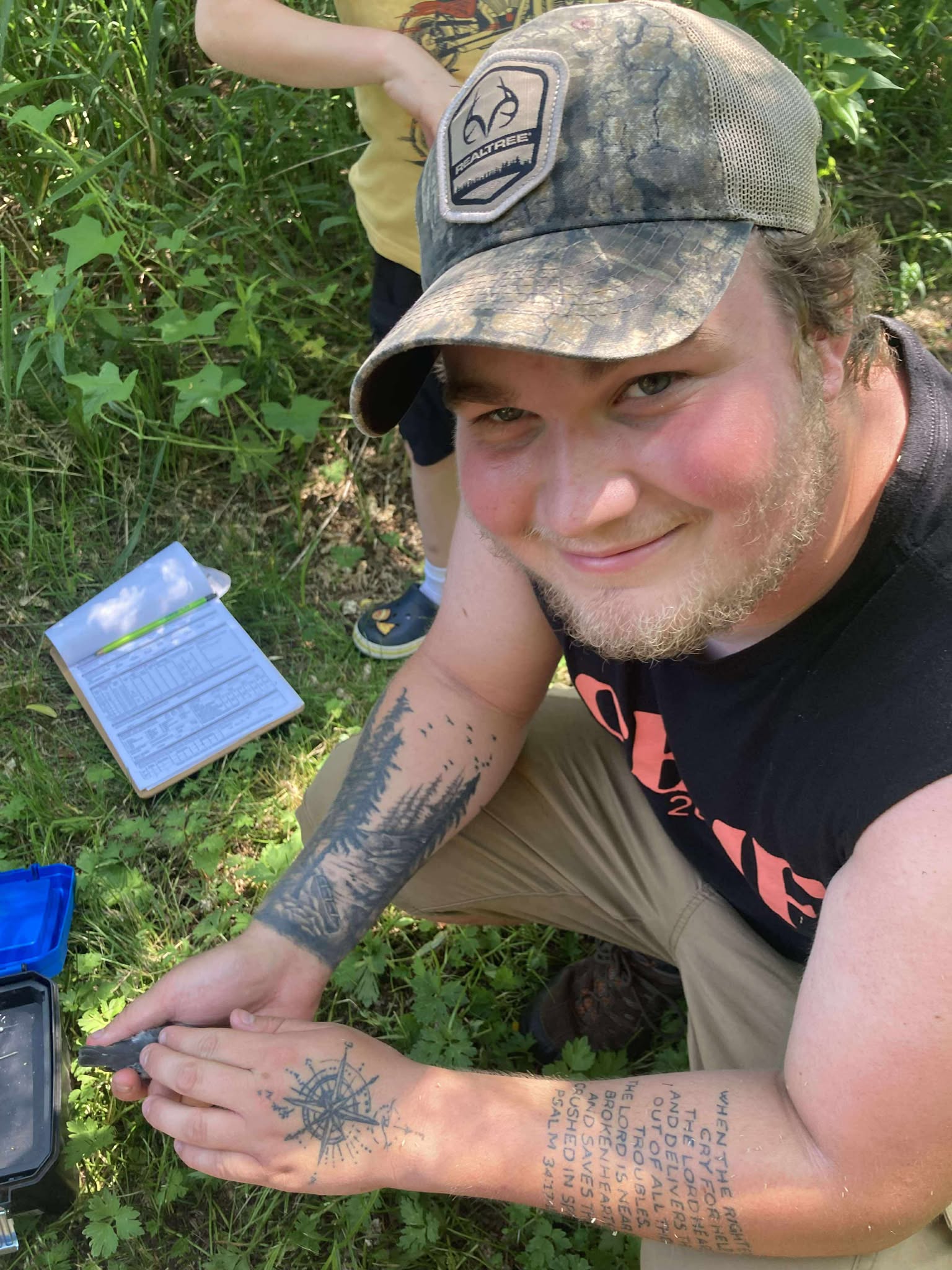
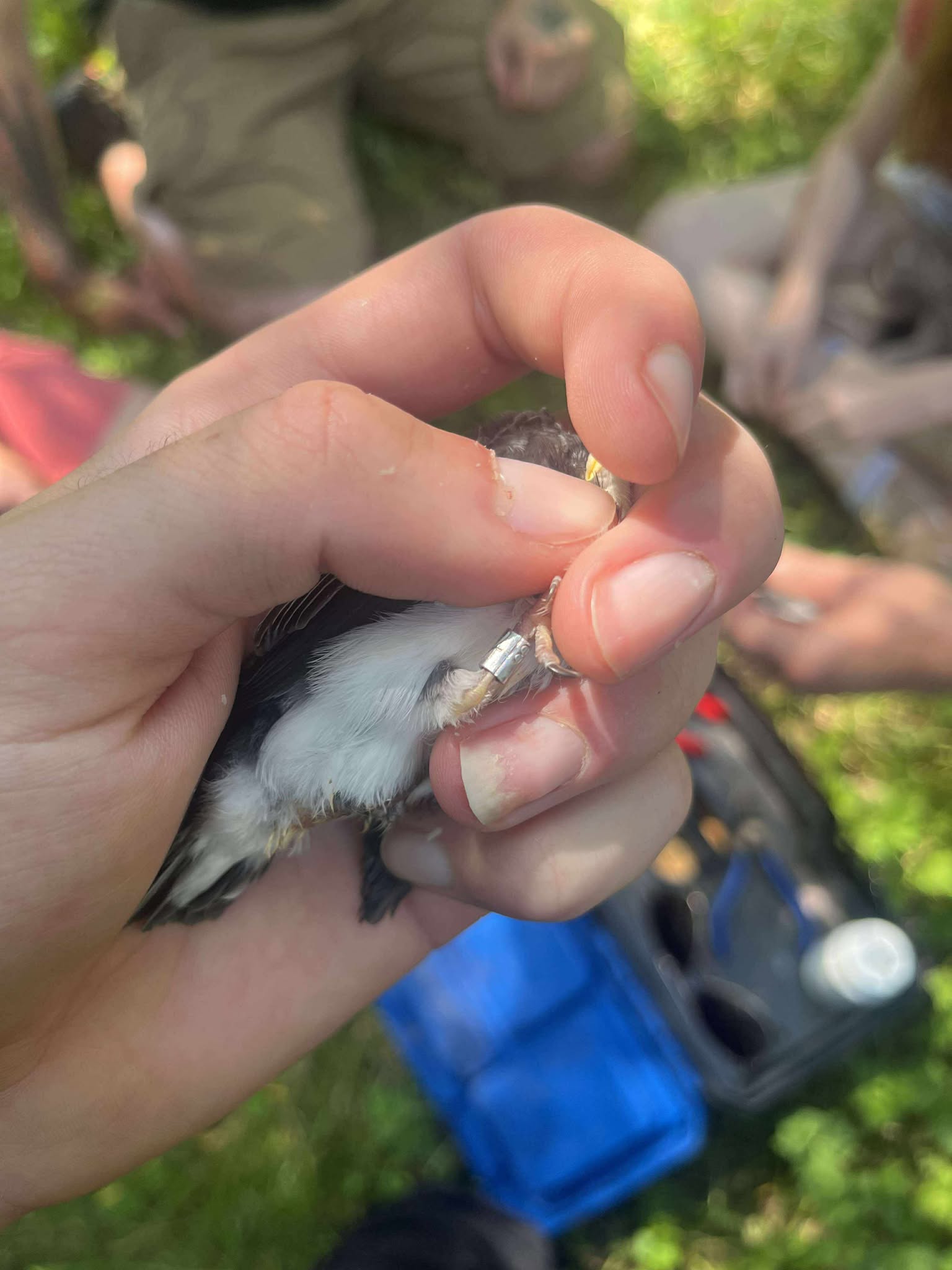
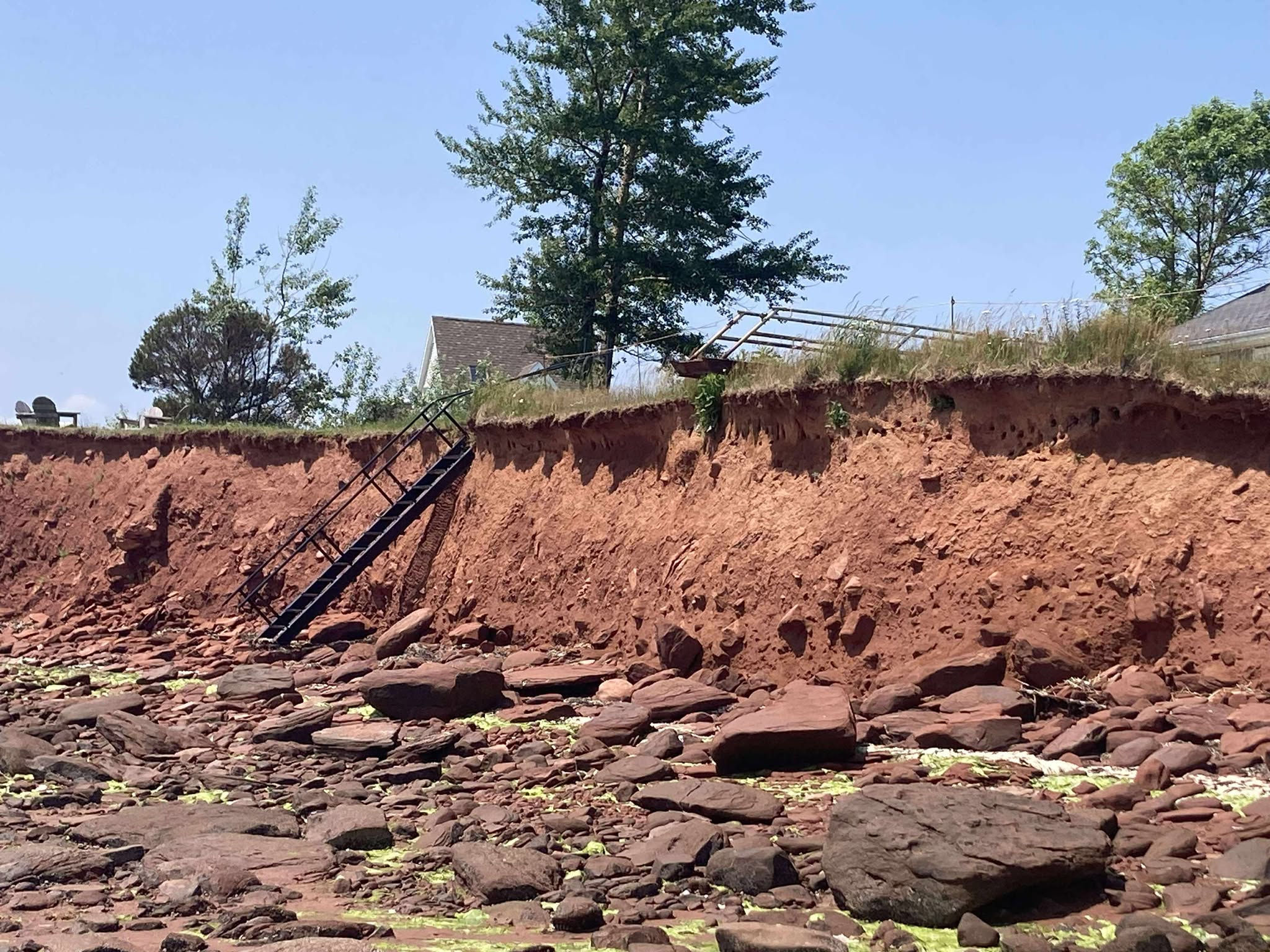
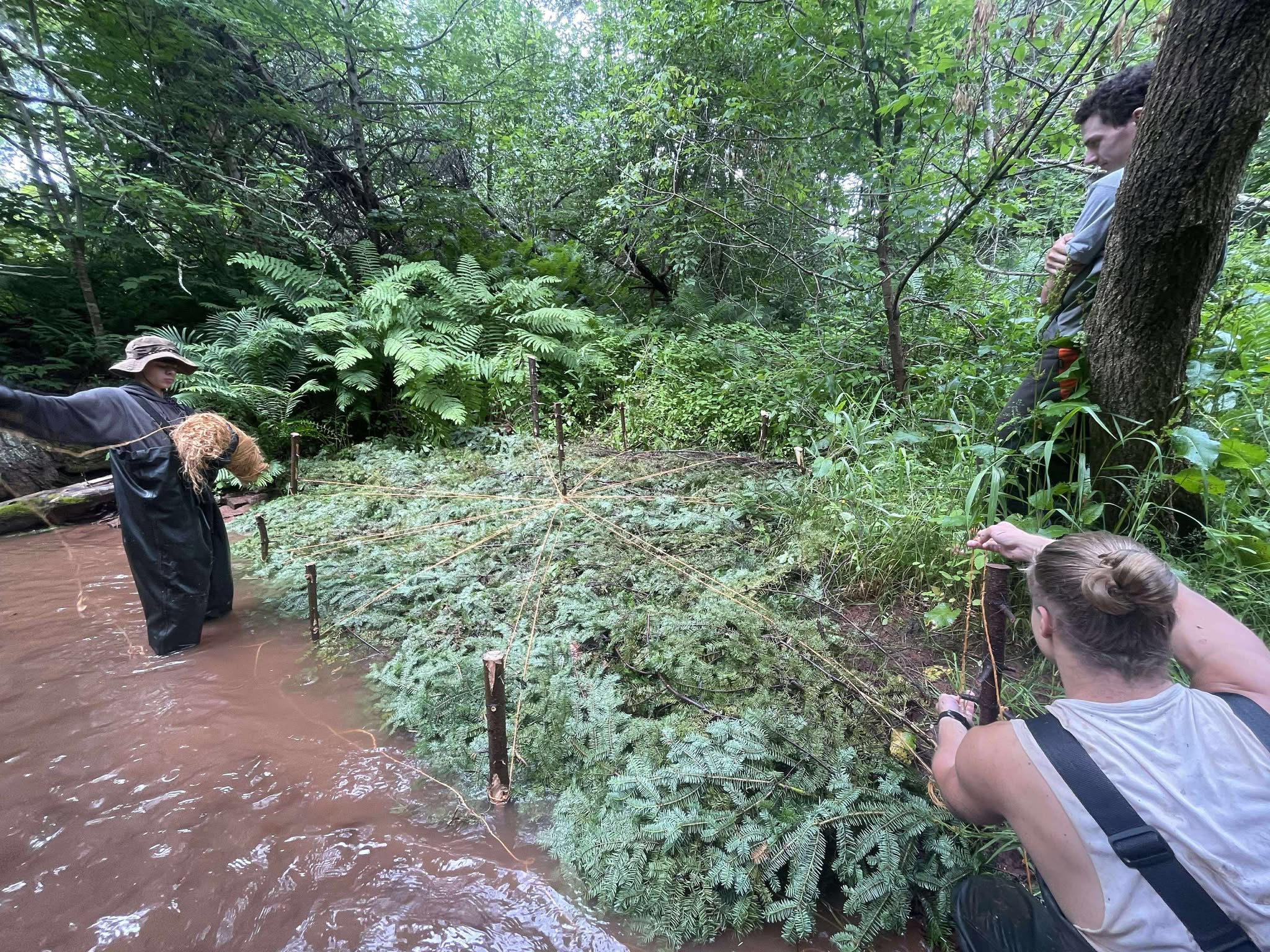
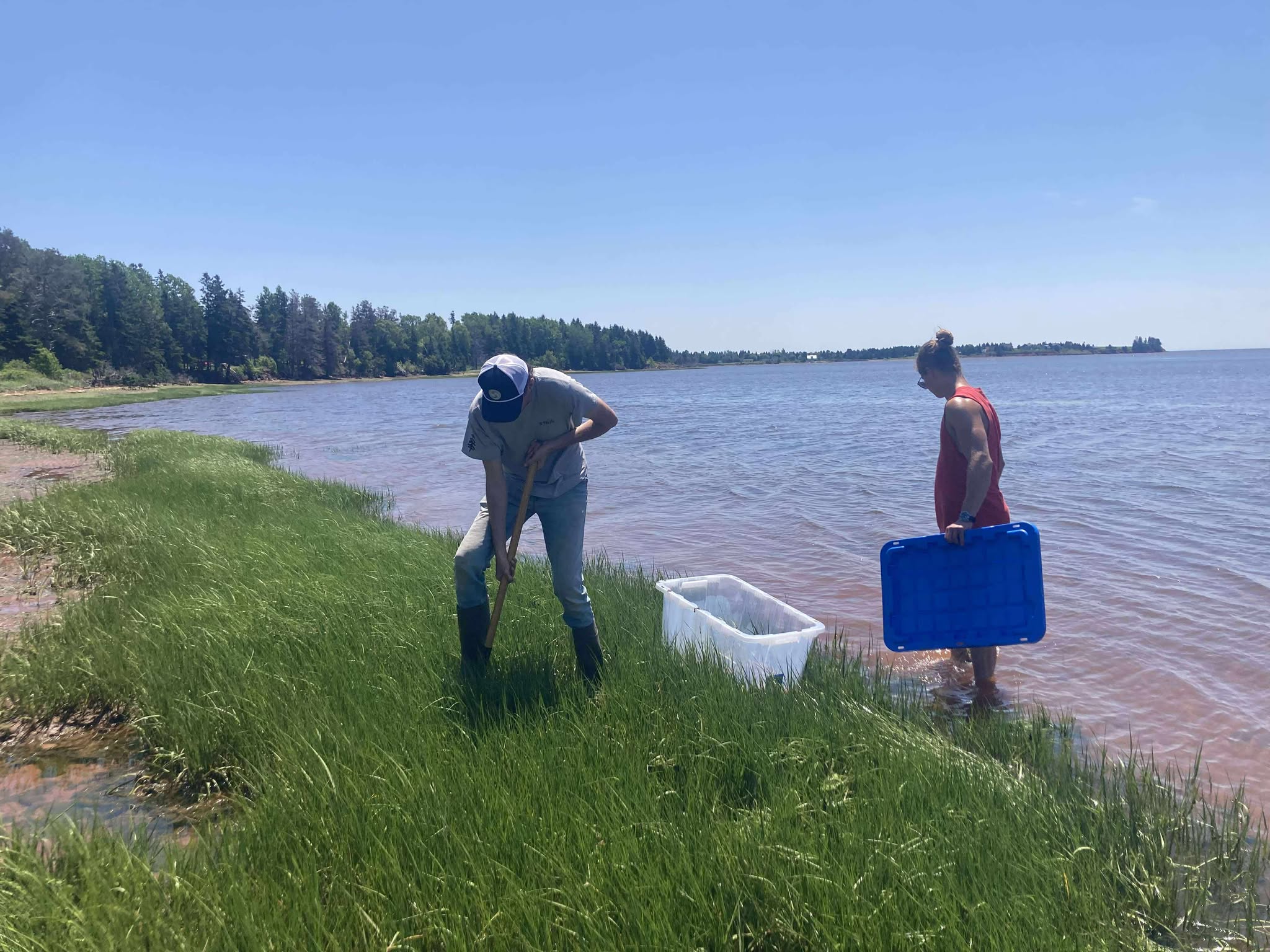
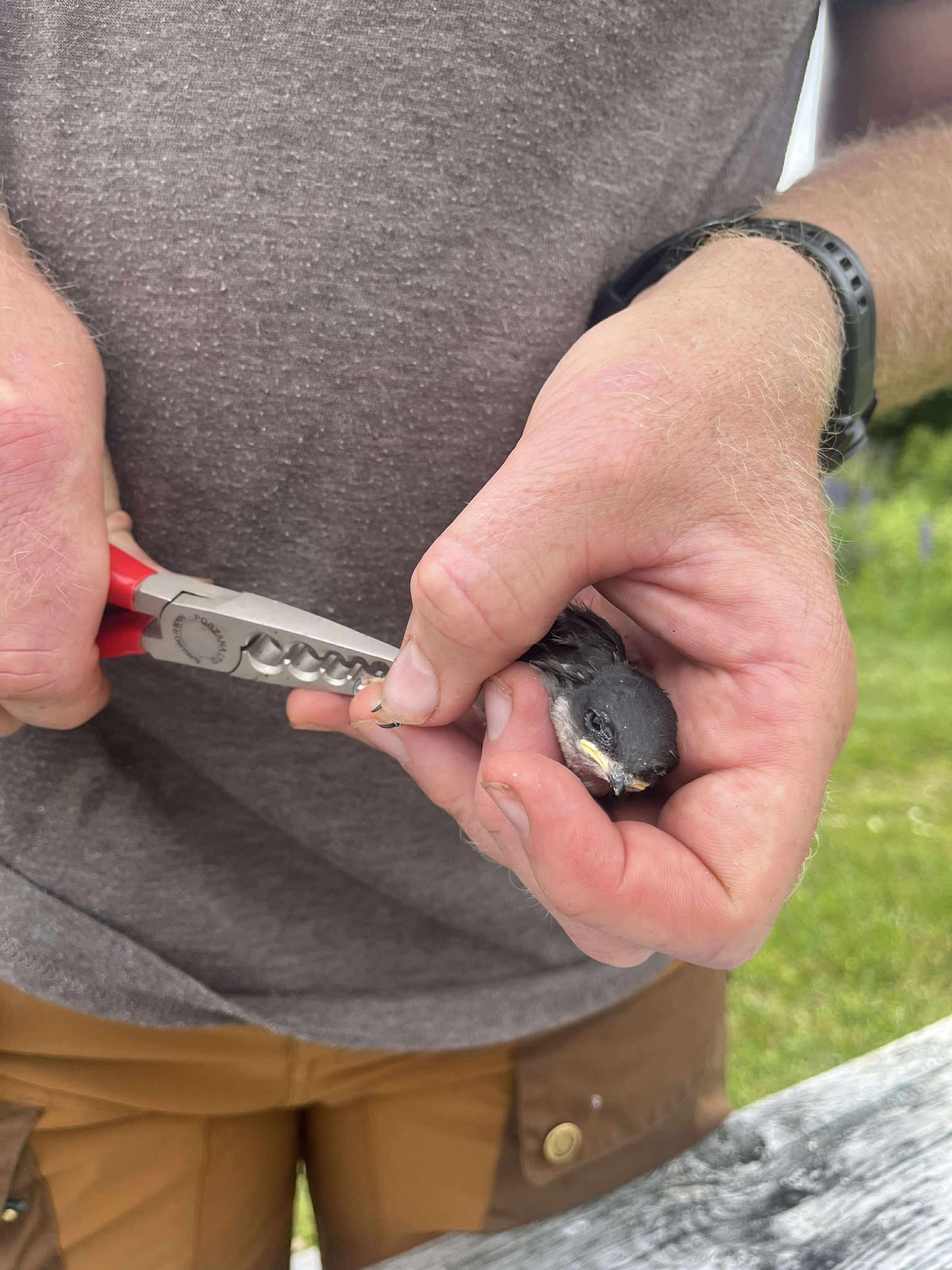
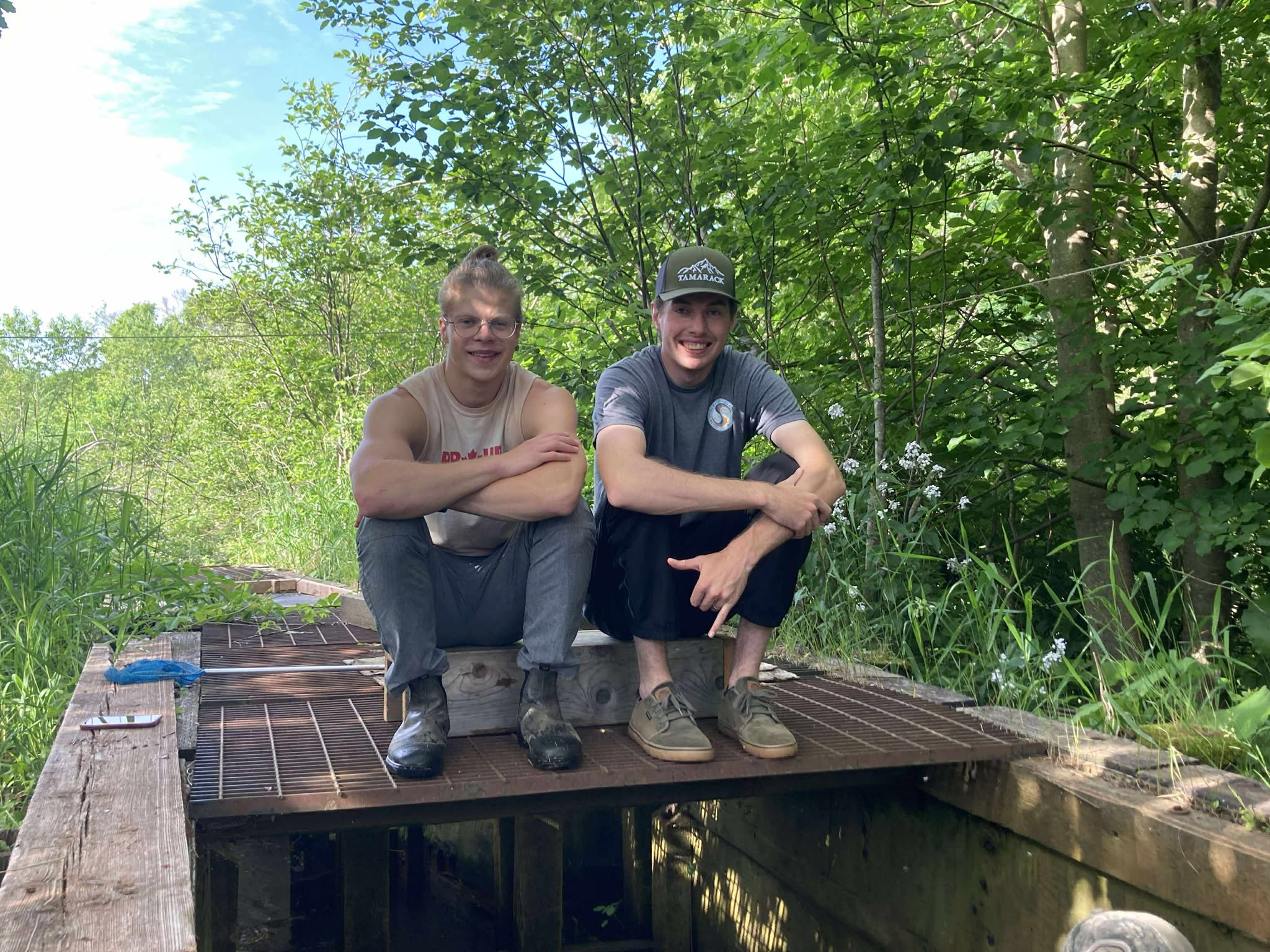
Heading Off into Summer
To start off our week, Monday, we built out some brush mats in Tryon to help support the stream banks and collect sediment. The crew also removed some blockages to the stream. In the afternoon we went to the DeSable estuary where we got some really cool shots and videos of the area with the drone. To finish the day went swallow banding with Matt Ginn since some of our chicks were the right age–you need to band them at 10 or 11 days old.
Tuesday we started the day off with headwater surveys off of the County Line Road. About a 45 minute hike through the woods to the stream headwaters, just to find out that one of them ran under a nearby field and was not flowing much in this dry weather. The other few were looking good and healthy. It’s important to check on the headwaters, because they influence the health of the whole river system. Once the survey was done Cam and Matt went around and checked trail cams while Ian, Teo and Nout went door to door handing out landowner permission forms.
Wednesday we were short two team members as Cameron and Ian were sent to do in the stream chainsawing training with some of the other watershed groups. Half of the team started the day off by checking quadrats to note any changes. At the same time the other half did some estuary monitoring. After the check the crew did yet another headwater survey, this one a little more lengthy. To finish off the day the team transplanted saltmarsh cordgrass into the saltmarsh restoration site in the DeSable Estuary. We are excited to see if it takes well to the area, and are happy to be back working on this project.
Thursday we had a small crew, but they got a lot done! Half of them went to water the trees we had planted a few weeks ago, which took most of the day since there are around 1300 of them. The two people went to clean up the parks and weed the pollinator gardens. With everything looking spiffy, now is a great time to get out and explore some of SSWAs natural parks!
To finish off the week, most of the team went to Branch road to finish up the stream restoration stretch there; this took most of the morning. In the afternoon the crew went and quickly checked our water temperature monitoring devices before heading off to the Linden Hill Pond and Lord’s Pond pollinator gardens to do a thorough weeding and trimming. Right at the very end of the day we trimmed up the edges of the Tryon River Trail and finished it all up with a quick tidy of the office.
Get out and explore!
Love, SSWA
Hatching Schemes
Week five started off with stream restoration on the east branch of Westmoreland. We are heading into the main portion of our summer work now as Cameron and Ian have recently obtained their chainsaw safety certifications and are doing a wonderful job leading the crew. Stream restoration is now focusing on a “less is more” philosophy, ensuring that large obstructions are removed, but enough natural debris is retained in order to maintain the natural habitat. Later that day Matt and Romy joined Forest Fish and Wildlife PEI to band the adult nesting tree swallows found in various boxes throughout the watershed area – many of the swallows had successful hatches, which is amazing.
In other news, the team obtained a water pump generously given by Frank, in order to water the earlier planted trees more efficiently. Doing so greatly increases survival chances of the trees, so we will continue to water them for the next week or two. Finally, part of the team travelled down to Mike’s property in order to observe an impressive and extensive patch of lady slippers. Mike also kindly donated a preserved female ruby-throated hummingbird specimen to display in the team office.
Tuesday, the team continued to water the planted trees. Additionally, the team returned to the stream restoration site from Monday in order to remove invasive plant species. The dominating invasive species was bitter-sweet nightshade. Some morning glory was noted, but did not pose a major concern. Two large notable patches of nightshade were removed. Fun fact: plant members of the nightshade family include trace amounts of nicotine (with tobacco being very high in it). These include common vegetables like tomatoes, potatoes and eggplants. Within these plants, nicotine serves as a natural pest repellent.
Wednesday was started off by checking on the progress of the tree swallows, and doing quadrat checks on saltmarsh grass. The team did some stream restoration along the western westmoreland branch and removed invasive species as needed.
Thursday, part of the team went off to monitor the 17 sites for water quality, while the rest tackled the eastern branch of Tryon river. There, the team removed invasive species and removed obstructions. Brushmats were also created for bank stabilization. All around stream restoration is our goal for the summer and we are off to a good start.
On Friday, part of the team continued with construction of brushmats, with the help of our new team member Rohan. The rest of the team monitored the progress of the tree swallows, and completed a water quality check for the western side of Westmoreland headwater.
Overall it was a great week with a lot of good work done!
Love, SSWA

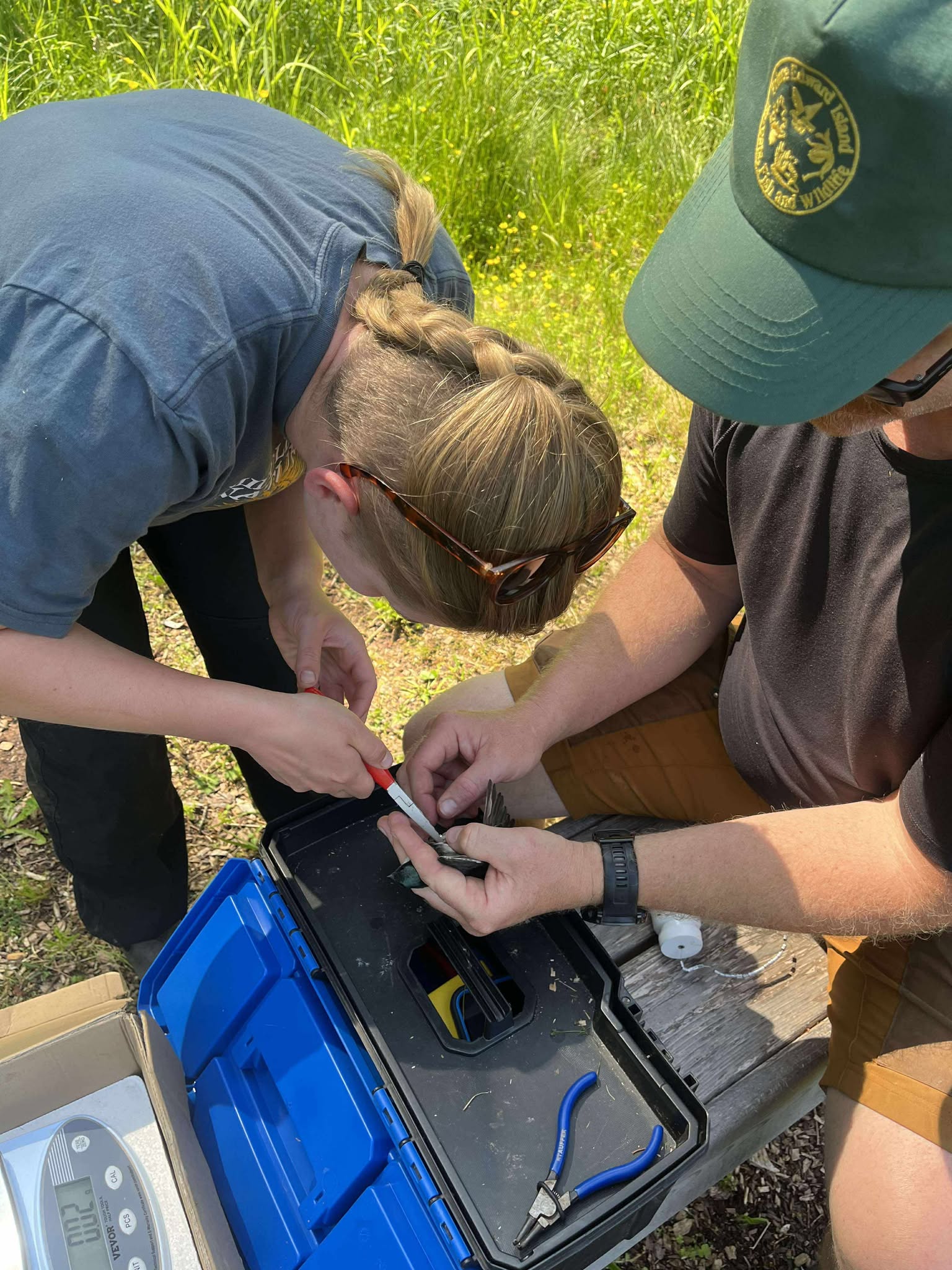
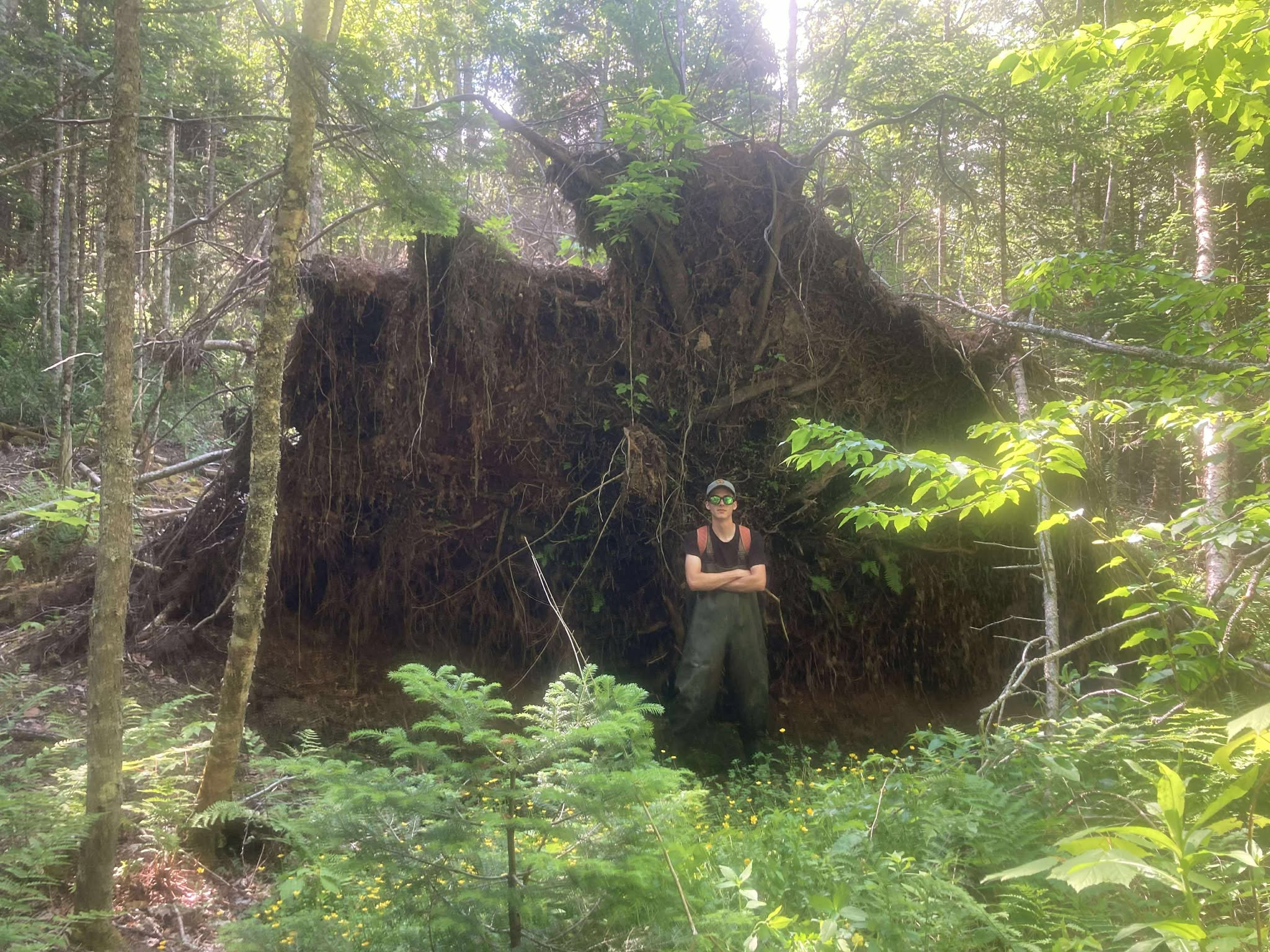
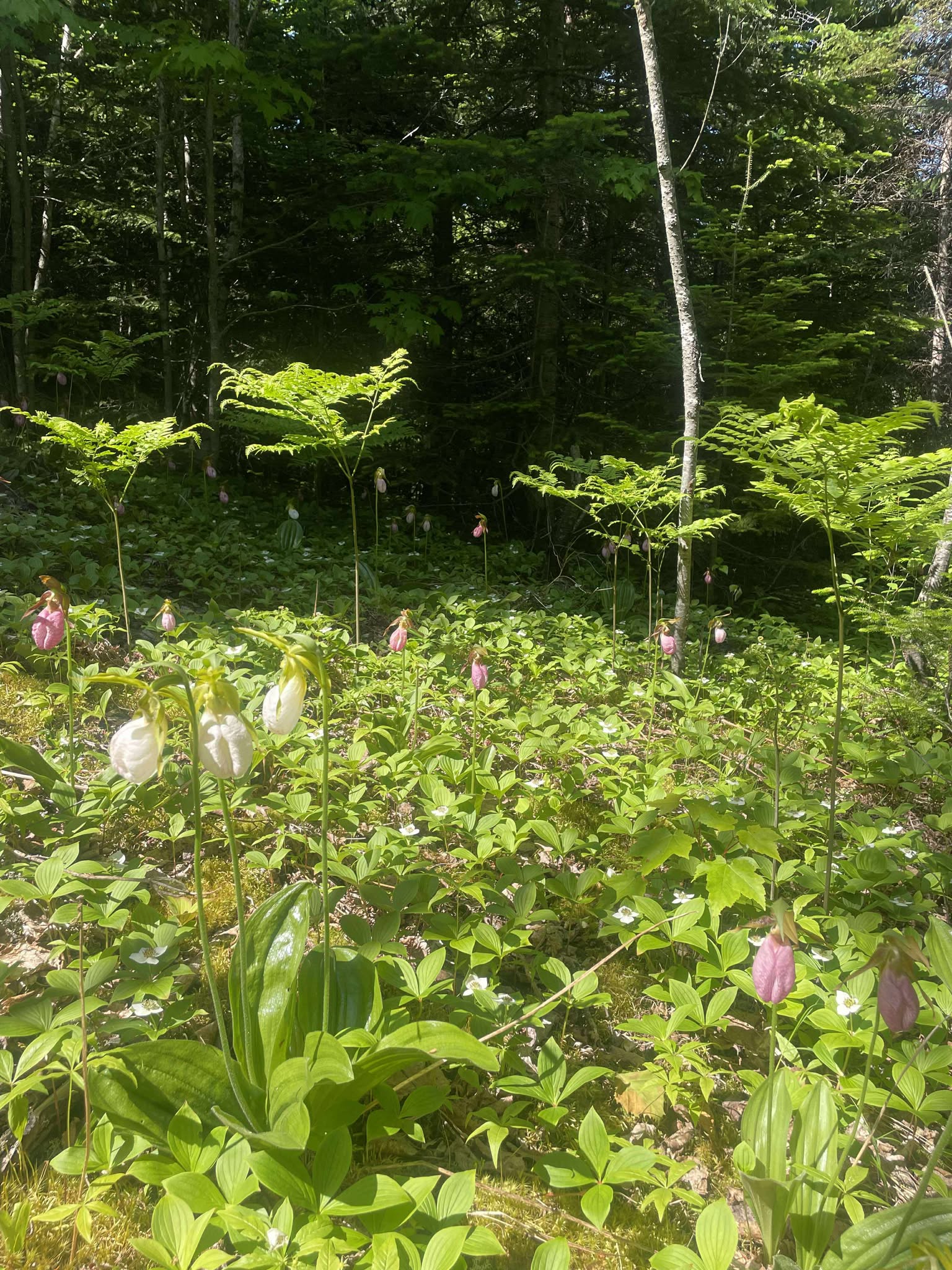
s
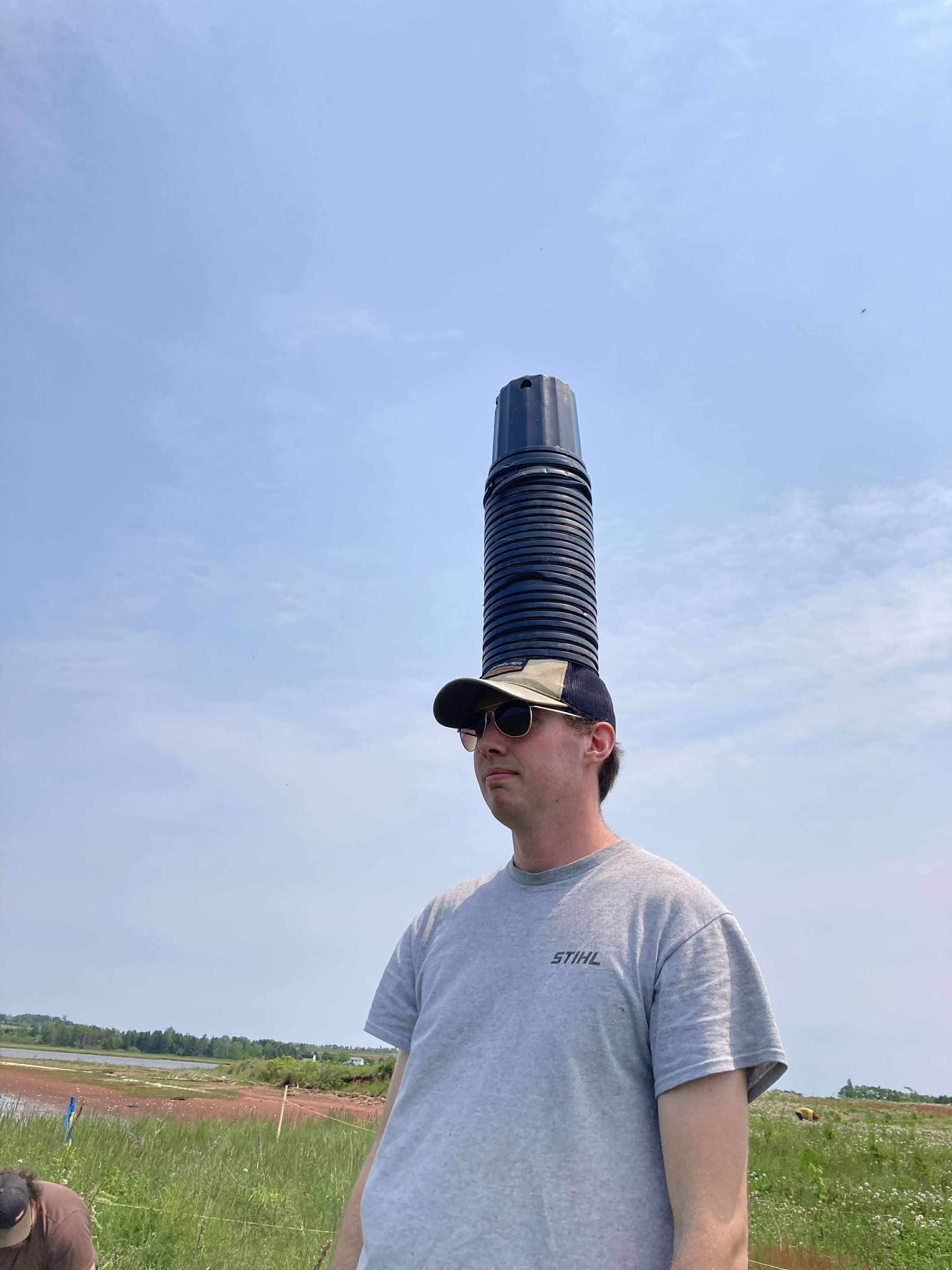
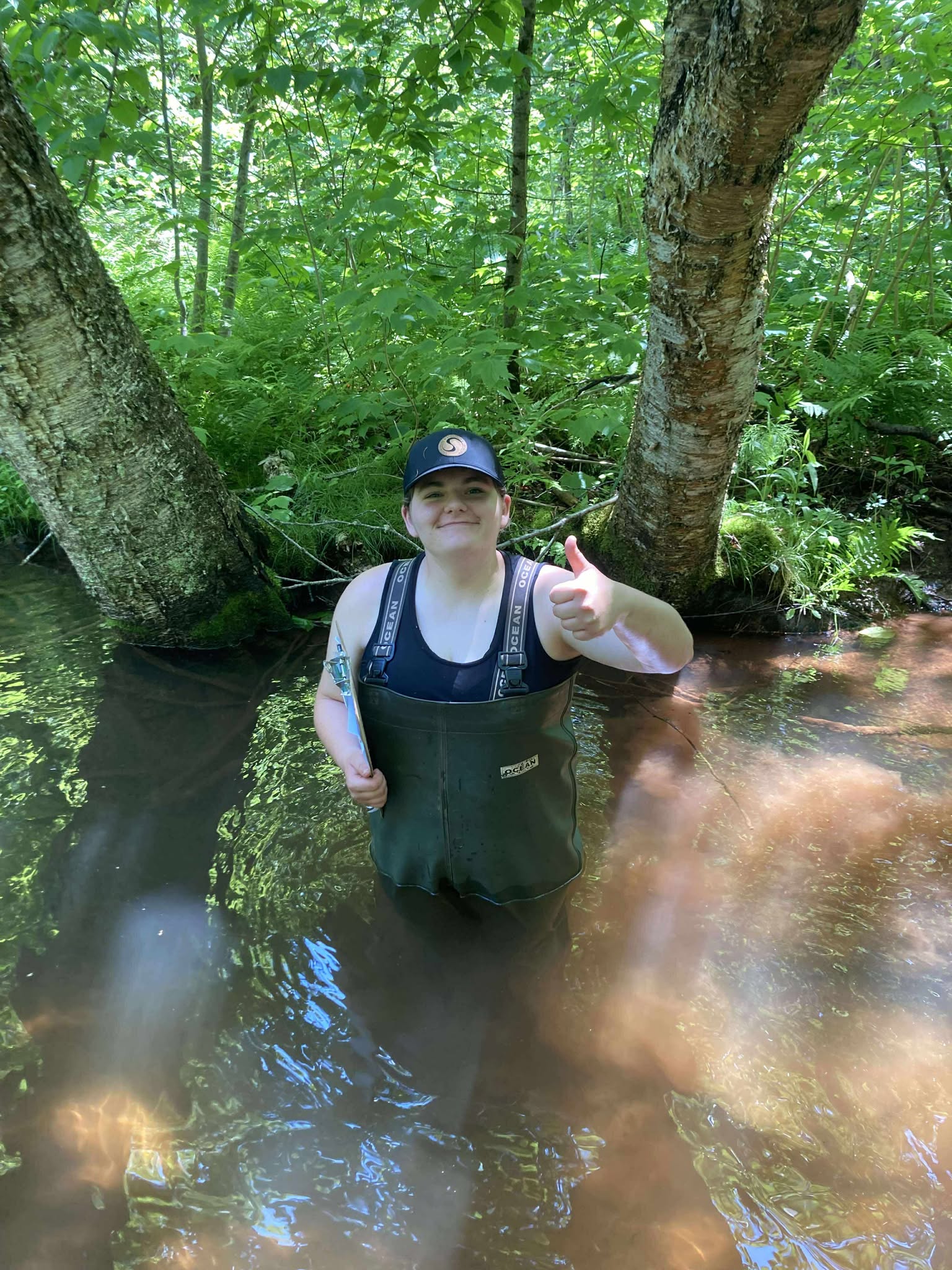

No Tree Leaf-t Behind!
Week four started in a very productive way, planting trees and shrubs to enhance the coastal buffer zone along the Westmoreland river estuary. Big thanks to the Kensington North Watersheds Association (KNWSA) for coming out for the day to help us plant around 800 trees and shrubs on Monday alone!
On Tuesday, the crew continued planting this riparian buffer while Ian and Cameron began their chainsaw training. Tuesday was also exciting because the first of our tree swallow clutches began to hatch! We saw some very very young birds in one of the nests when we went to check, and we are looking forward to the rest of our nests hatching soon.
Wednesday morning, the crew finally finished planting the last of the riparian buffer zone, totaling roughly 1300 plants! In the afternoon, half the crew went out to do a stream assessment in Tryon, while the other half talked to some landowners in our watersheds to ask permission to conduct our work. If you have not given us permission, live in our area, and own property with a stream or estuary on it, please fill out and send us a permission form LMIK. While most of the crew was hard at work, Ian and Cameron were tearing it up at chainsaw training.
Thursday, Matt and Nout went out to Kensington to help out KNWSA with their Grade Six Environmental Fun Day, by running a Tree Identification station. Afterwards, Island Falconry came out to show off two of their raptors to the kids, and Matt and Nout got to hold the Peregrine Falcon! The rest of the crew started park maintenance and did a stream survey in Tryon while avoiding the thunderstorms.
On Friday, some of the crew went out to maintain the rest of the parks, and the others went out to make brush mats. All in all, a very productive end to the week.
Hope you can find some sun!
Love, SSWA
Trees, Trees and More Trees
Week 3 started off with some more of our annual stream and head water surveys. This information is greatly needed for us to decide an action plan to ensure the stream remains as healthy as possible. We also finished checking the remainder of the trail camera photos that we collected last week. One of the cameras had a snowshoe hare that we slowly watched change back to its summer coat. Every time it ran past the camera it was a little more brown. And where was the boss when all this happened? NOWHERE TO BE FOUND!!! Just kidding, Matt spent some time on Monday learning how to do a forest bird count survey in Belfast. We may start to introduce this monitoring protocol into our work, so it was good to learn some more about how BAWG does it.
Speaking of bird surveys we continued to monitor our tree swallow boxes to check for eggs. While we found nests and eggs from tree swallows in many of our survey sites, we also had a surprising discovery that a Black-Capped Chickadee decided our survey box is more suitable for its nest than those pesky tree swallows. So now we are tracking the progress of a Chickadee nest as well. We also continued with our Quadrat Salt-Marsh surveys and our fish trap survey. This marks the first week we ever got fish every day we checked the trap.
During the mid-late week our attention was shifted to trees as we received trees for our first major planting project this year. 1800 trees were delivered to SSWA this week as we begin the largest planting season SSWA has ever seen. The next week or so is going to be spent planting a coastal buffer zone with around 1300 trees and shrubs! Look out for before and after pictures over the next year as this project progresses.
Thursday we did our second public event of the season with Ron. The crew and members of the public gathered at the Tryon Trail and went birding. Ron, an avid birder in the area, led us around as we looked and listened for the birds as we tracked them on the Merlin Bird ID app. We were excited to hear a catbird and a Northern Cardinal but did not see either of them. It was fun to learn from such an experienced birder, and some of the crew got excited to start using Merlin in the field.
To wrap up this busy week we conducted another stream assessment and headwater survey, did some park maintenance at the Daryl Guignon Memorial Park in Crapaud and planted even more trees.
Stay tuned for more interesting updates as our season progresses!
Love, SSWA
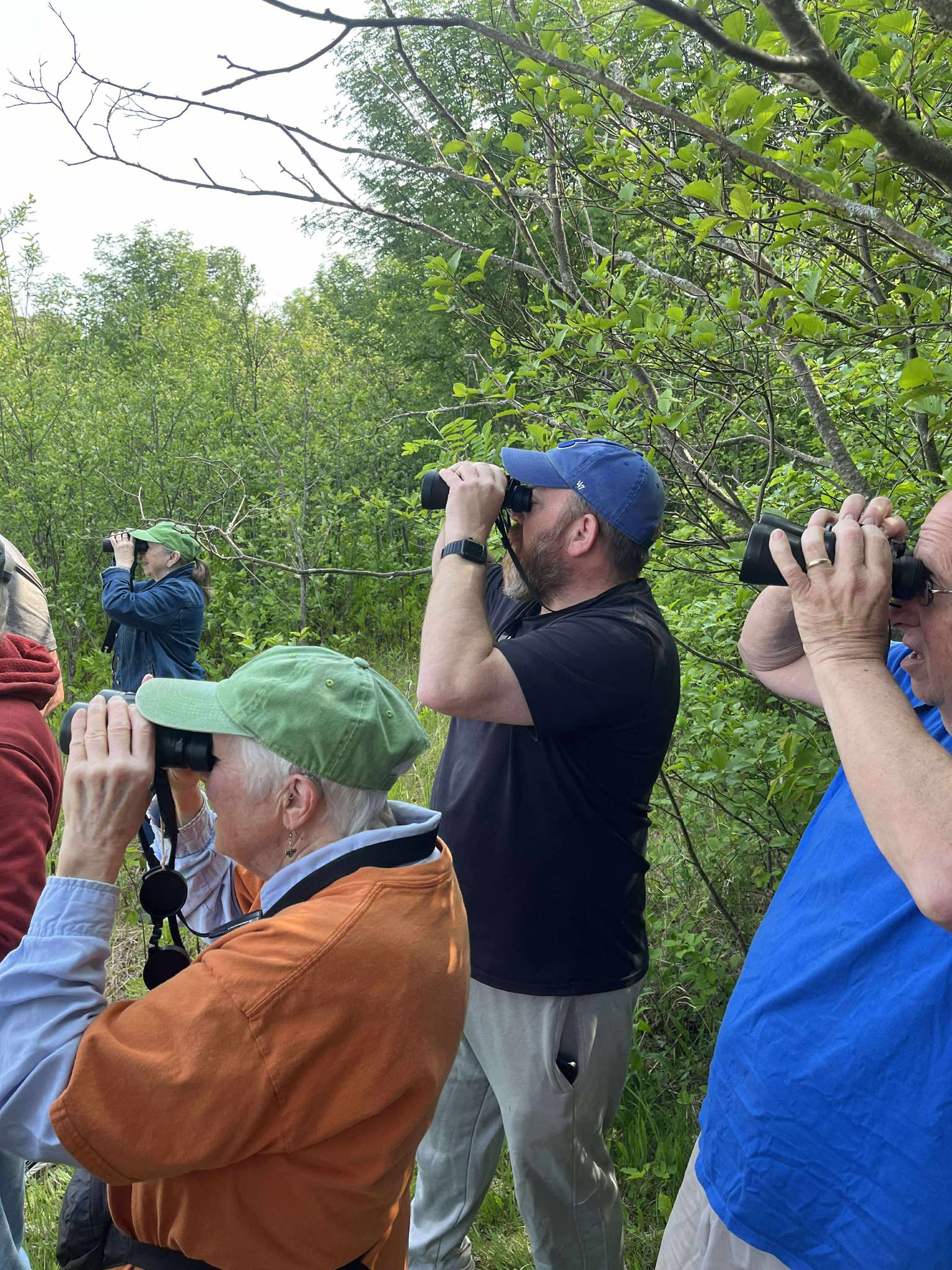
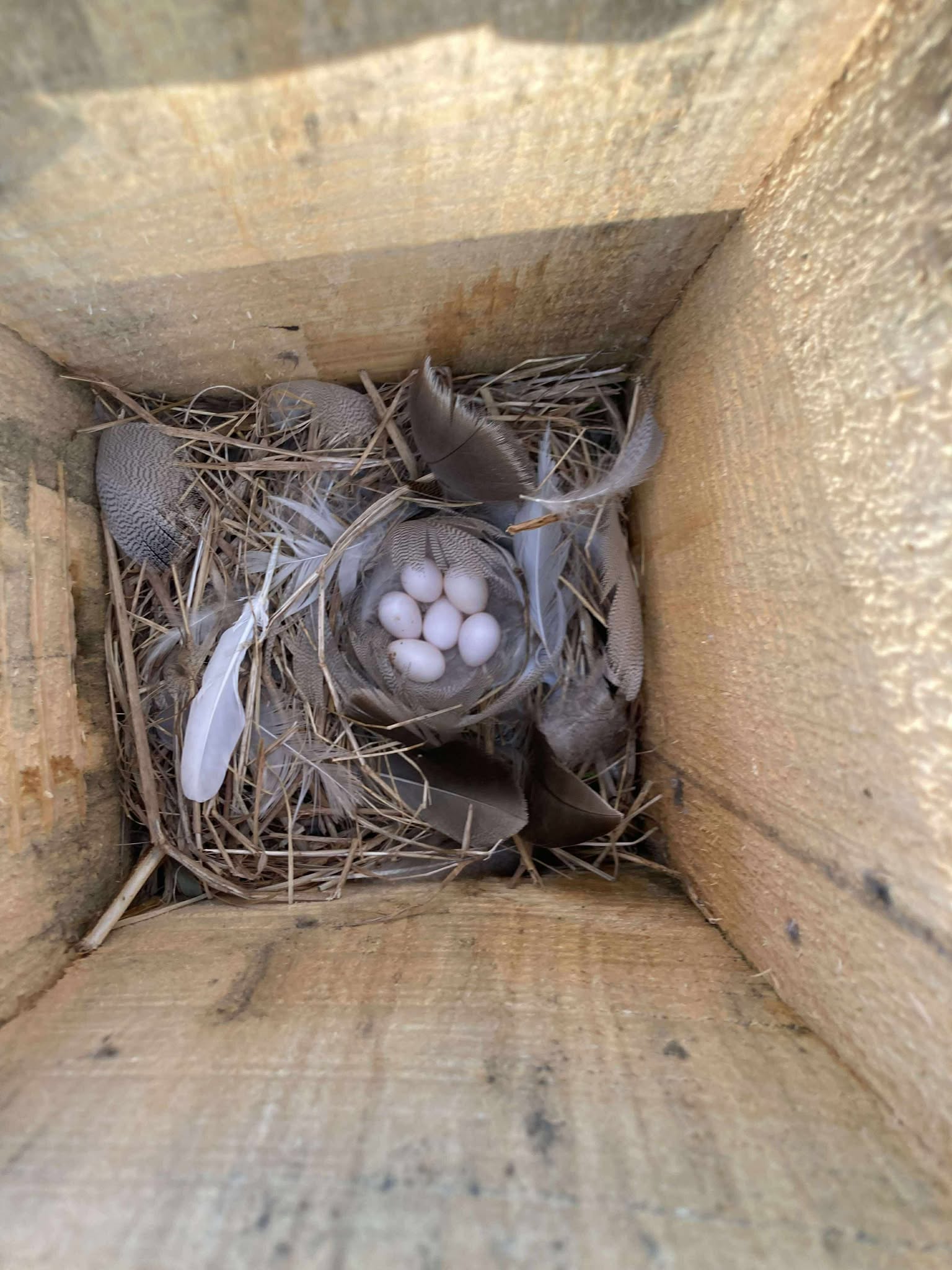
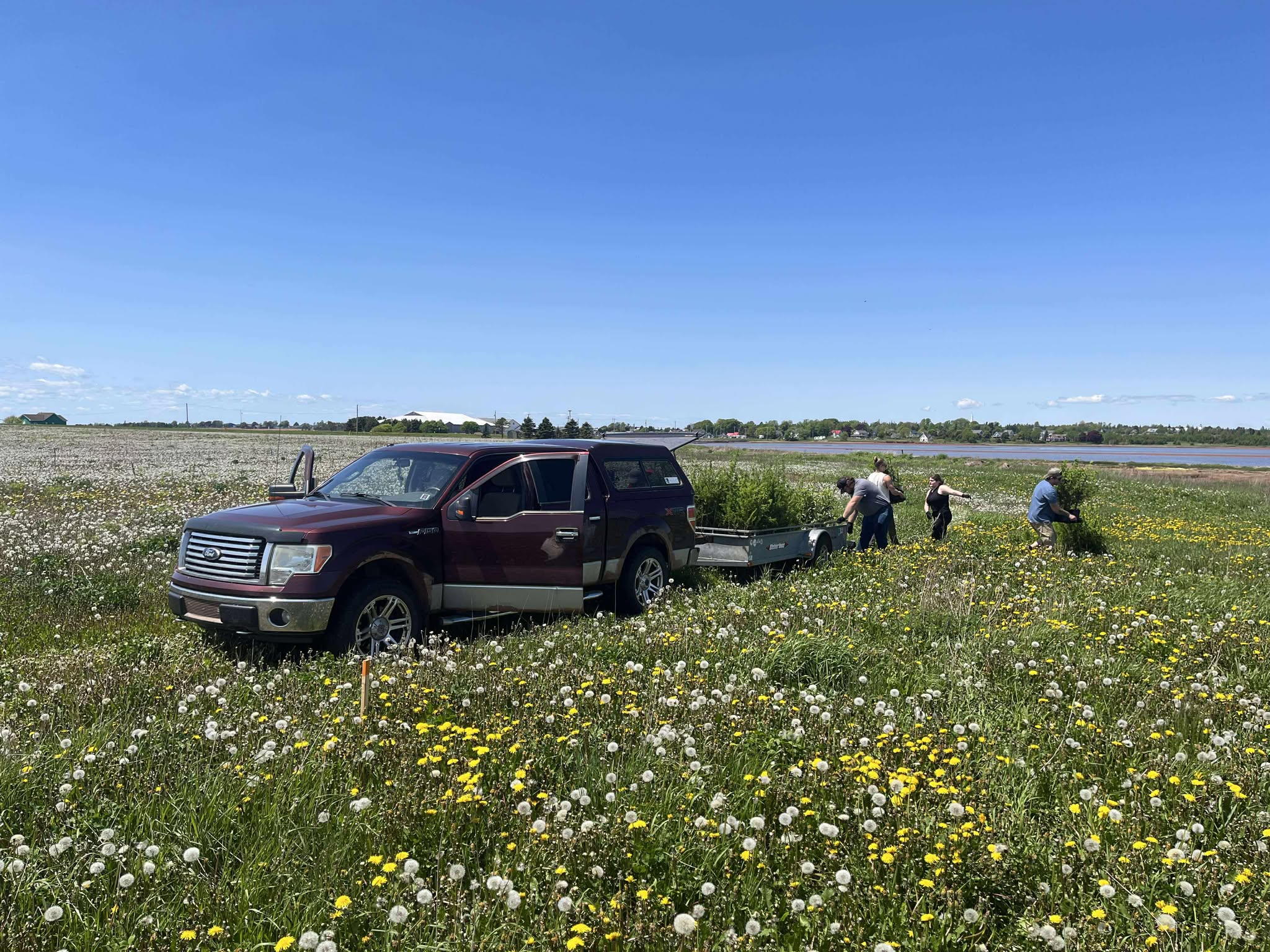
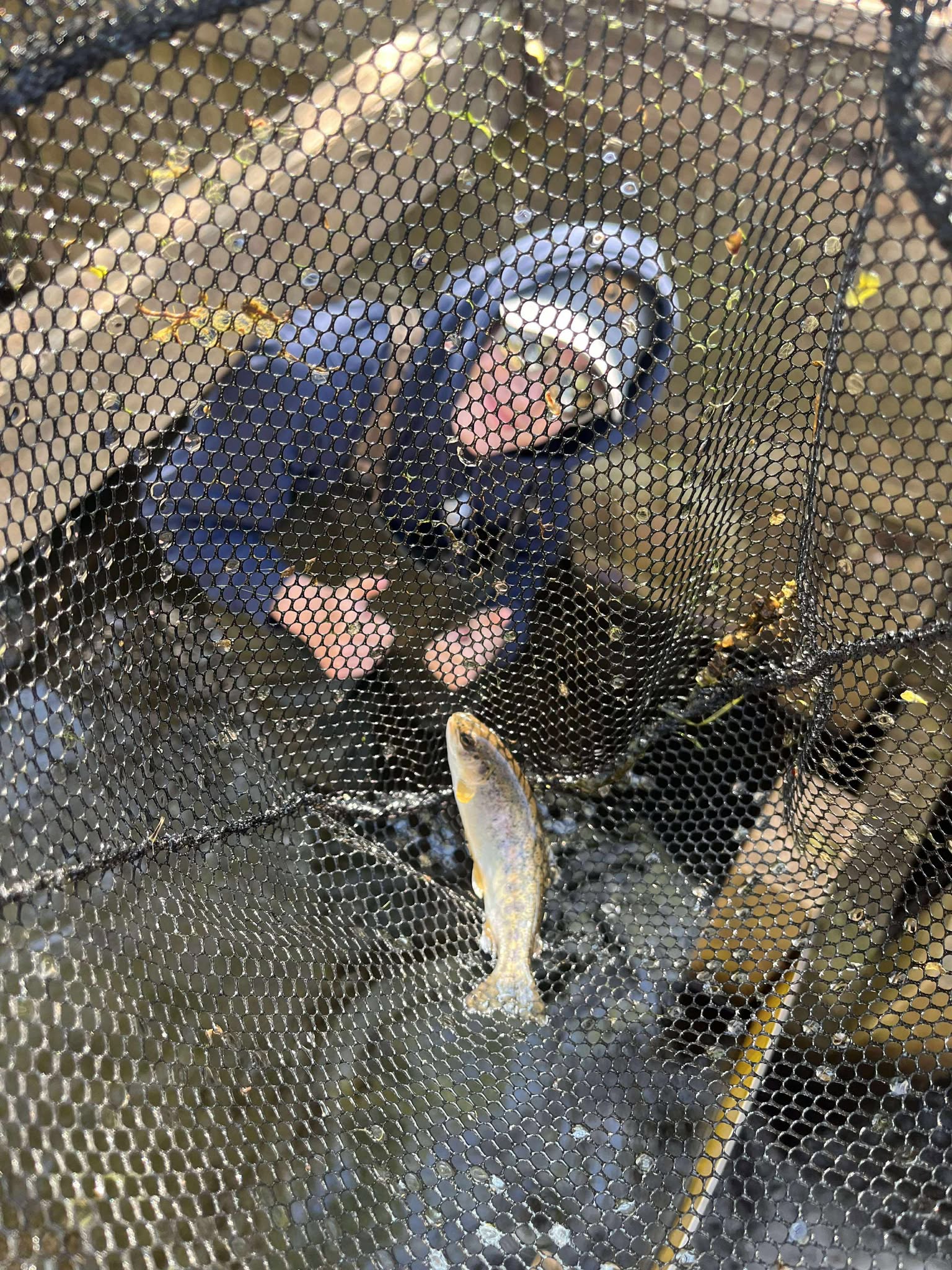
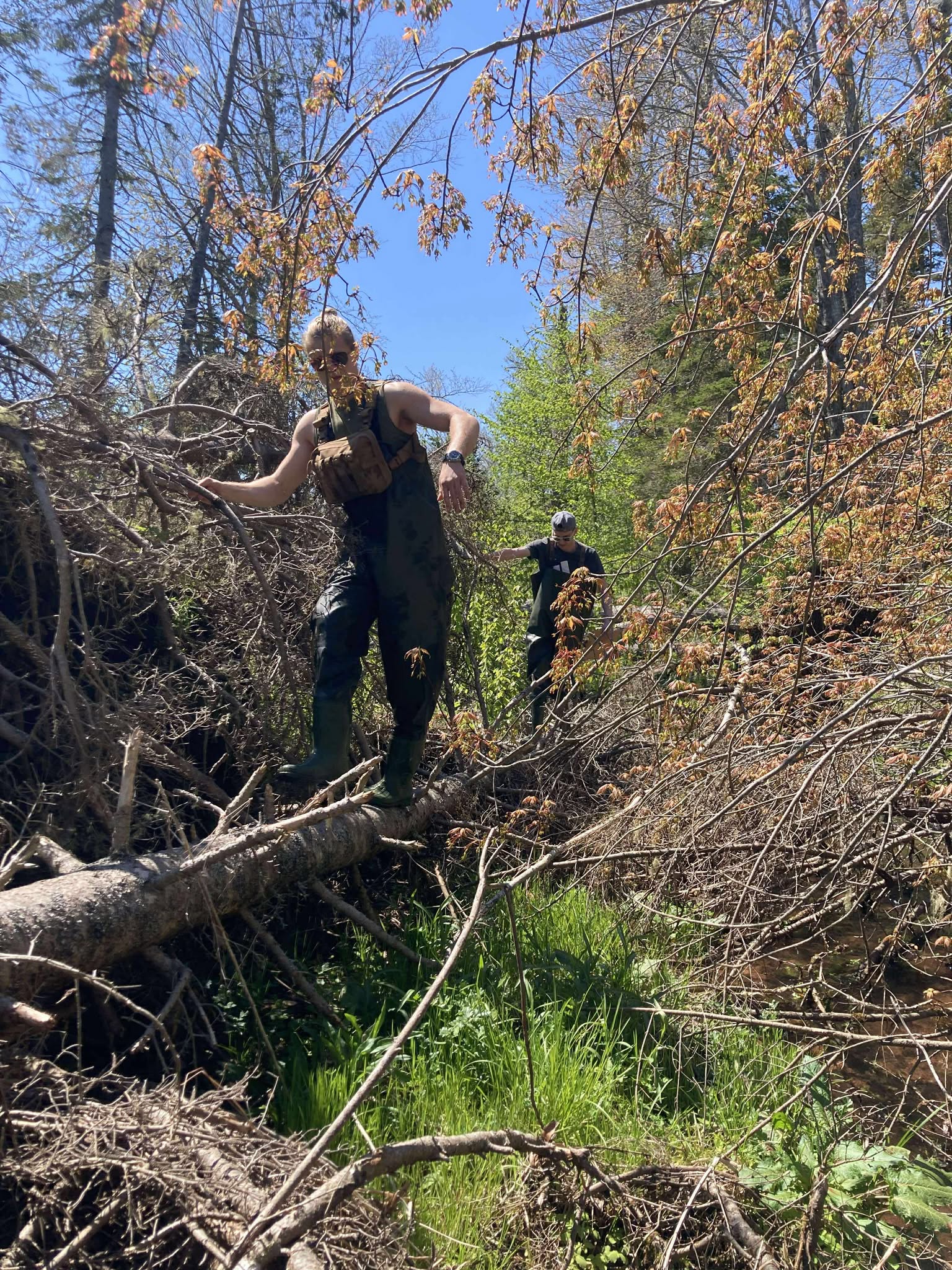
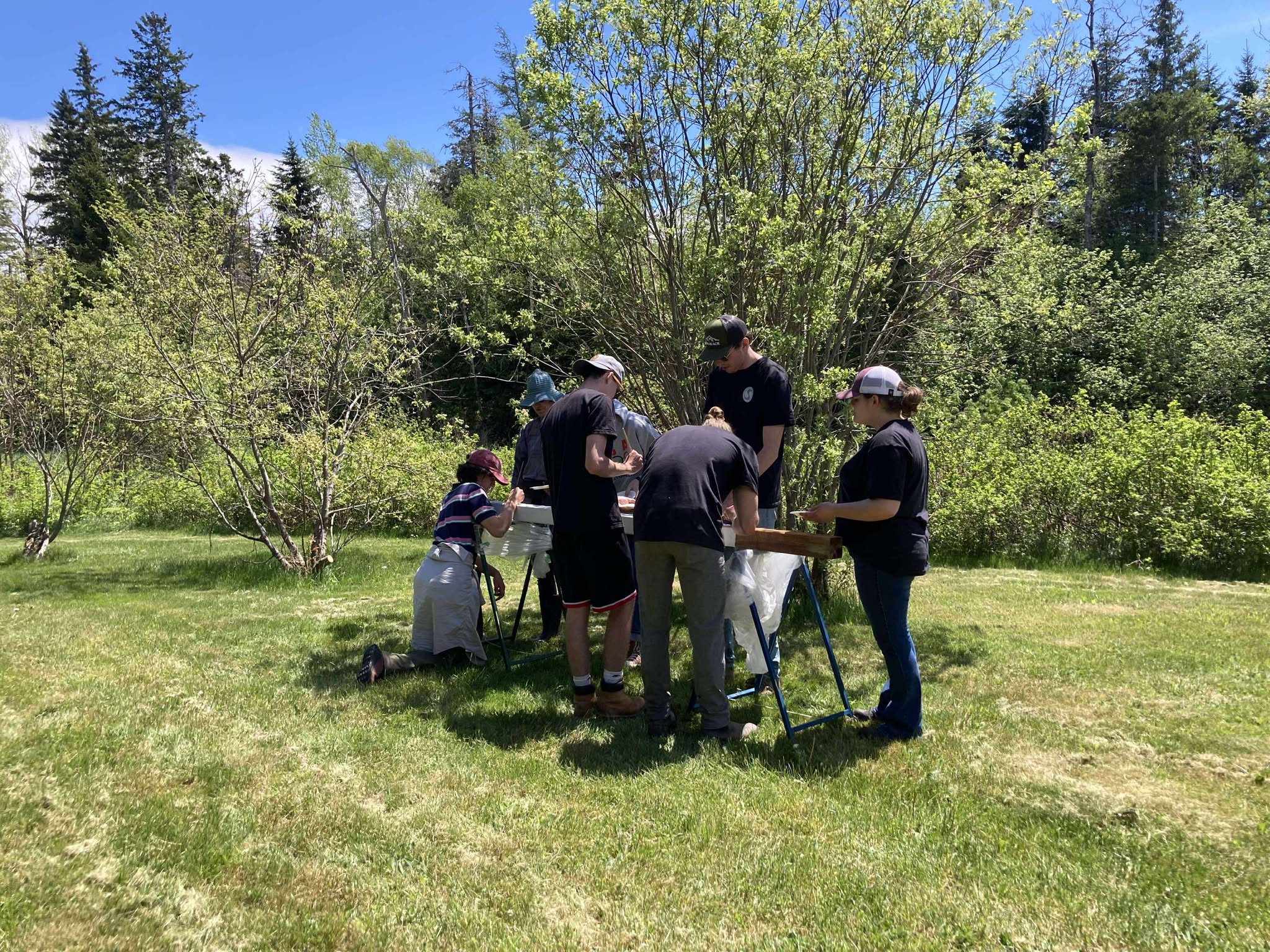
Warming Up
This week started off with some cleaning and tidying of our pollinator gardens and Linden Hill Pond Park and Lord’s Pond. We also checked out the extension of the Tryon River Trail to see if there were any trees that had fallen over the winter. We want to ensure that our trails are spiffed up in time for this summer season. That afternoon, we conducted the first of a few redd surveys to look for the nests of Rainbow Trout. They are the only fish in our streams that nests in the springtime so any redds we see, we can be sure are from Rainbow Trout.
On Tuesday more data was collected from the trail cameras and captured photos of a ruffed grouse, a coyote and a field mouse! It was also our first day of checking our fish trap in Lord’s Pond, which will now be checked everyday in June in hopes to record some data on fish passage up the fish ladder there. On the first day we were able to record measurements from one small rainbow trout and luckily as the week went on we were able to record measurements from six other small rainbow trout!
Next up, was to check the quadrats in the salt marshes to measure the grass so we can monitor how well the grass is growing and get an idea of how good the environment is within the estuary. The other part of the crew spent this morning putting in three brush mats! Off to a good start on our restoration efforts. The afternoon was spent conducting a stream assessment and redd survey in Westmoreland.
Starting Thursday off strong, we did some park maintenance at Linden Hill Pond Park to get ready for the event on Friday. We also continued our stream assessments in the Tryon watershed, which is one of our surveying priorities this spring–we have not conducted stream assessments in Tryon since PTS Fiona.
To finish off the week, we did some trail maintenance at Camp Abegweit and repaired the fish trap, which was somewhat worse for wear. In the afternoon we hosted Art in the Park at Linden Hill Pond Park where we painted a peace pole! It was wonderful to see people come out to such a positive event and the pole will be erected in the park in a couple of weeks. If you’re in the DeSable area, feel free to check it out! And if you’re sad you missed the event, keep an eye out next May–we host Art in the Park each spring.
We had a great week full of fun and laughs, and are excited to see what next week brings us!
Stay cool!
Love, SSWA
May Showers
Welcome back everyone to another summer season at SSWA! We are excited to be back at work in the streams with the summer crew starting this week. Our first week started on Tuesday with the installation of water temperature monitoring devices across all of the watersheds. We also spent some time going through our trail cameras. While going through the cams we stumbled upon a beautiful capture of a coyote in broad daylight. It seems like he saw something he liked around our trail camera. In the afternoon we wanted to see what some of our streams looked like and what work needed to be done to them.
The next day we wanted a jump on some early maintenance for our park locations. We started park maintenance by the Westmoreland Pond in the first half of the morning, then the second half we touched up the pollinator garden at the Daryl Guignon Memorial Park. In the afternoon we installed some quadrats which are used to monitor salt marsh grass and health and performed checks on our tree swallow monitoring boxes.
Thursday we took the whole crew out for a chill morning of water quality testing. In the second half of the day, as water quality took up all morning, some of us completed the tree swallow check and did another stream assessment in the Tryon area, the rest of us finished up going through our trail cam photos.
Ending off the first week of work we were limited to what we were able to do as it was pouring rain for most of the day. We did end up mowing and cleaning up some of our pollinator gardens before the rain got too bad, but the rest of the day was spent cleaning up the office and entering the data we had collected all week from different monitoring projects.
Happy to be back!
Love, SSWA
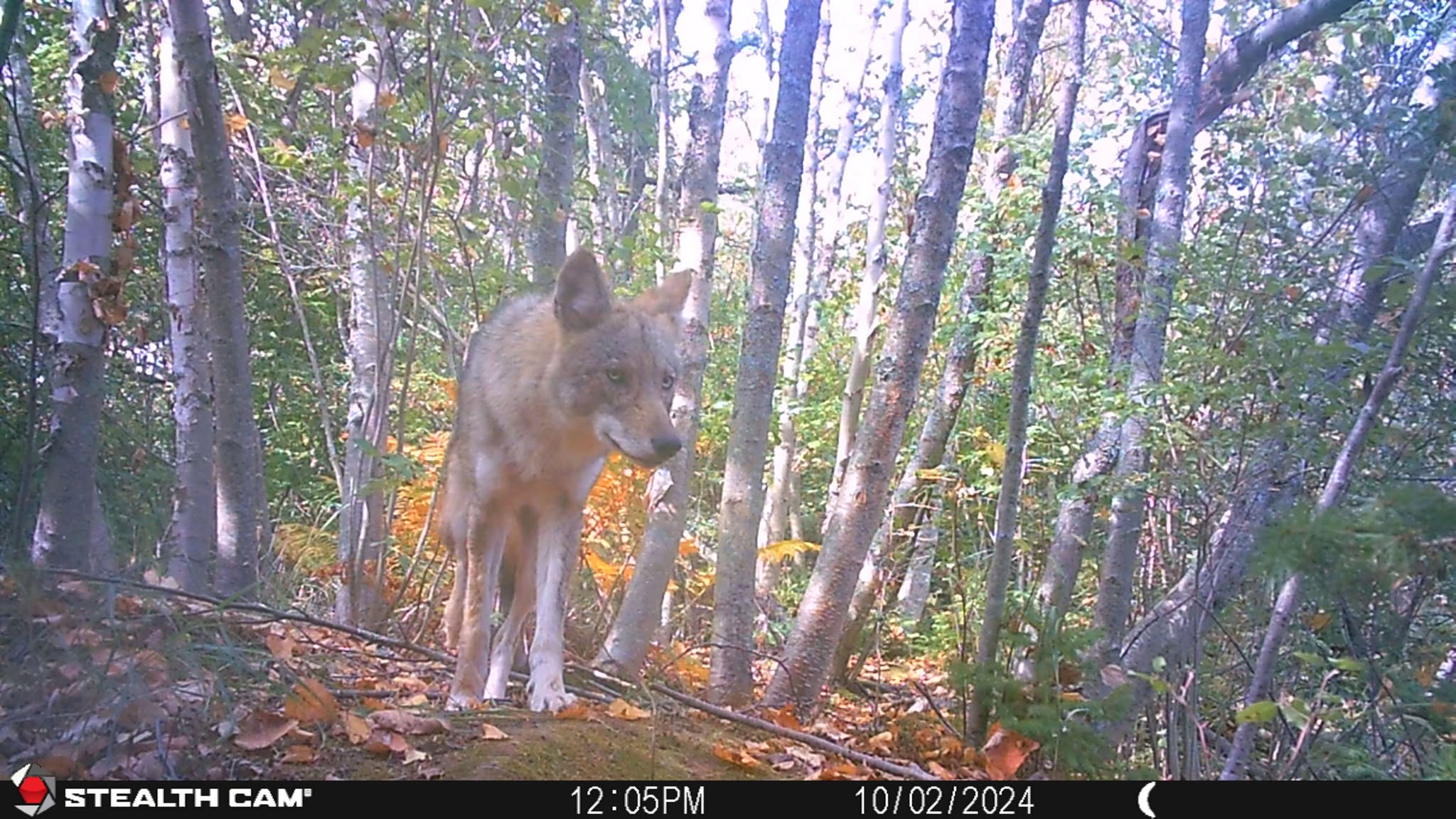
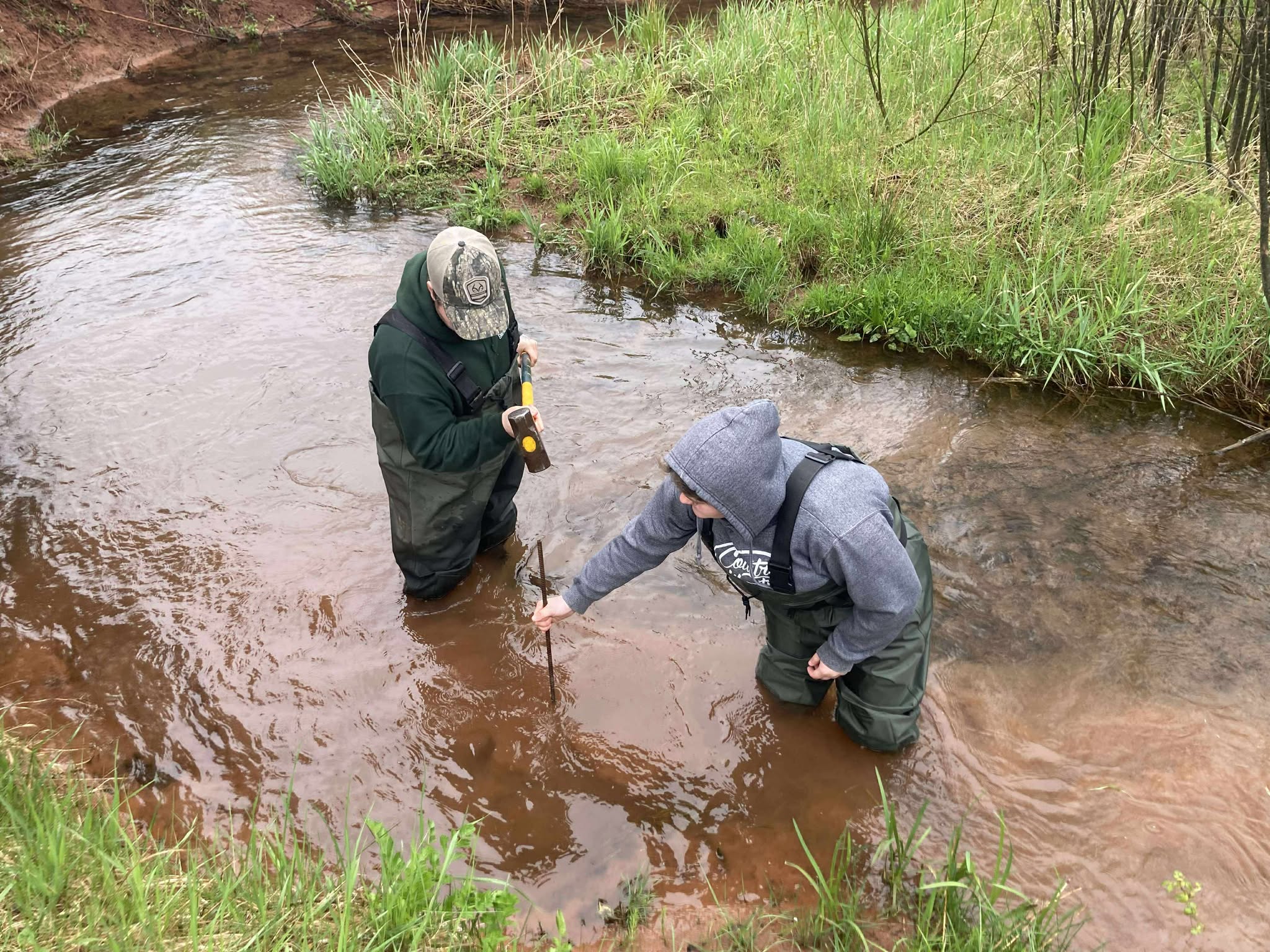

 using WordPress and
using WordPress and